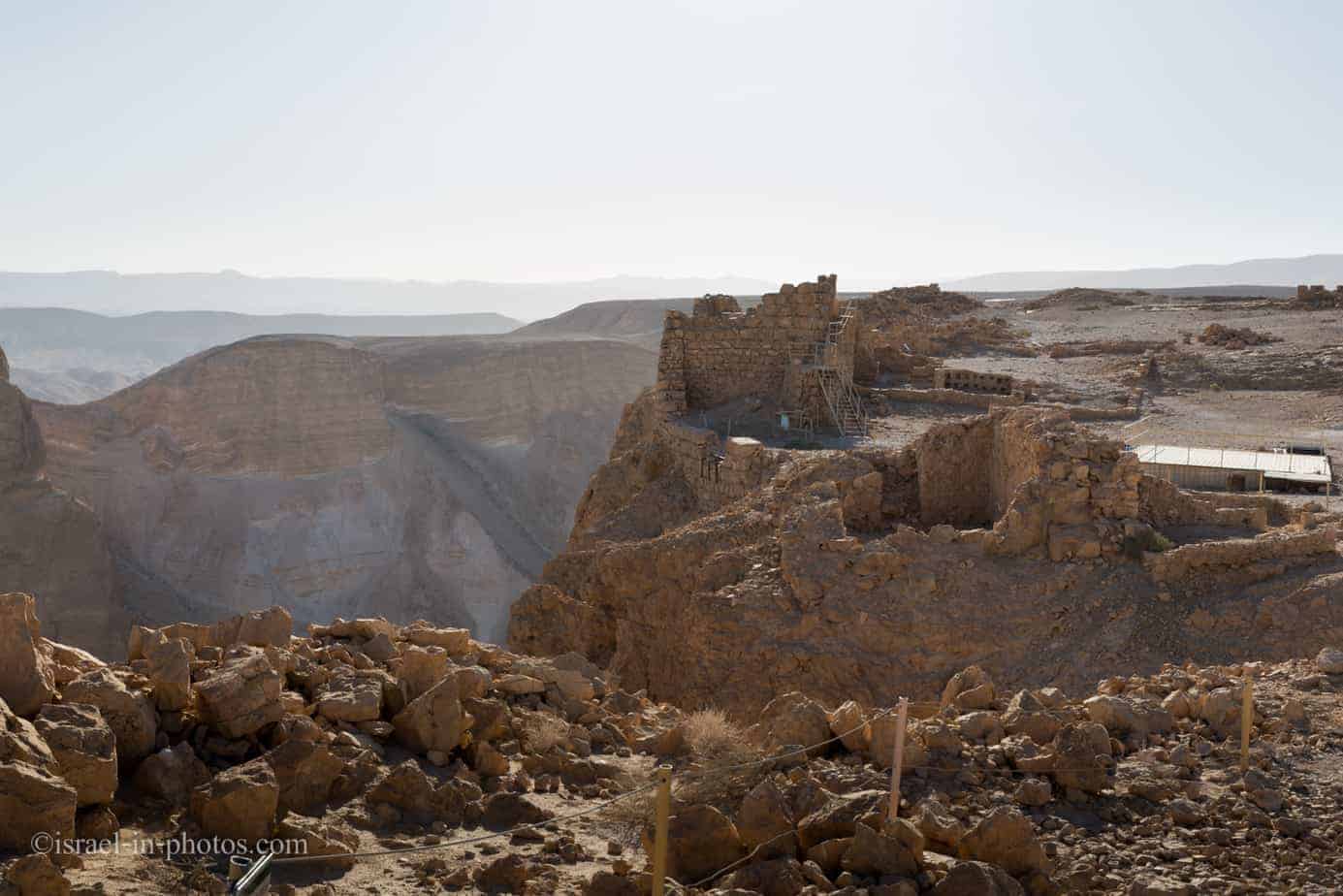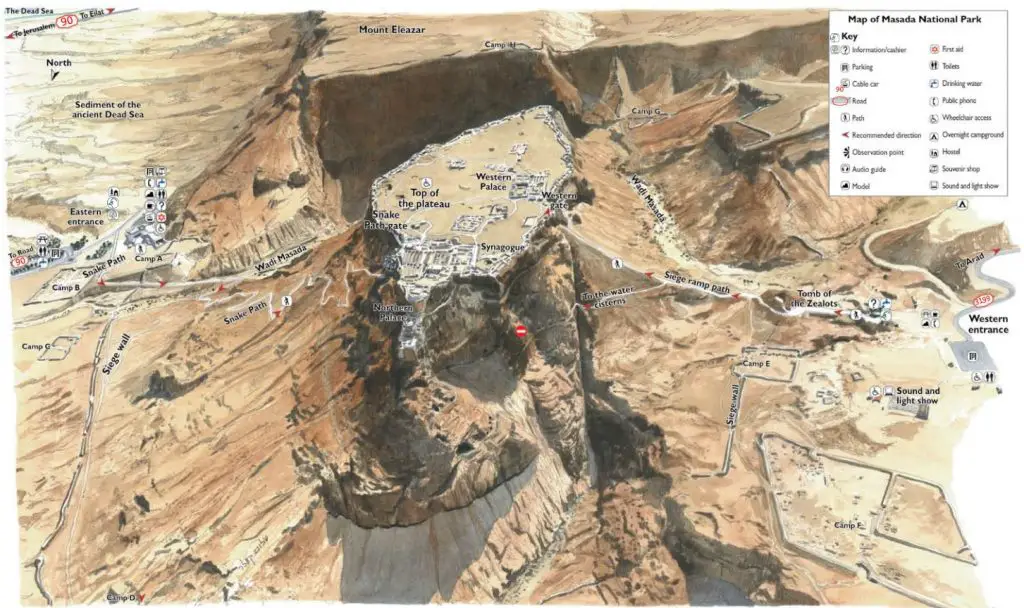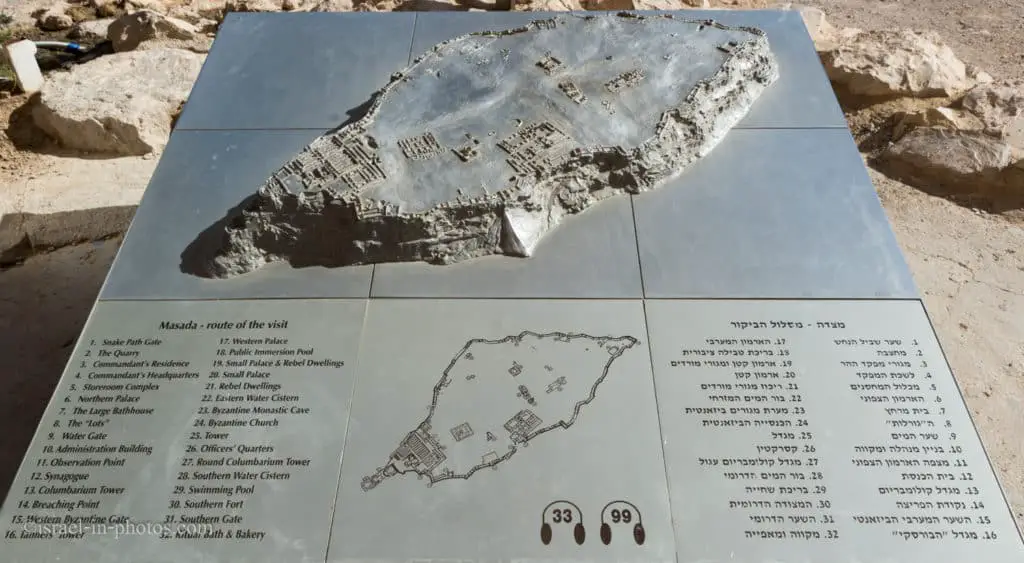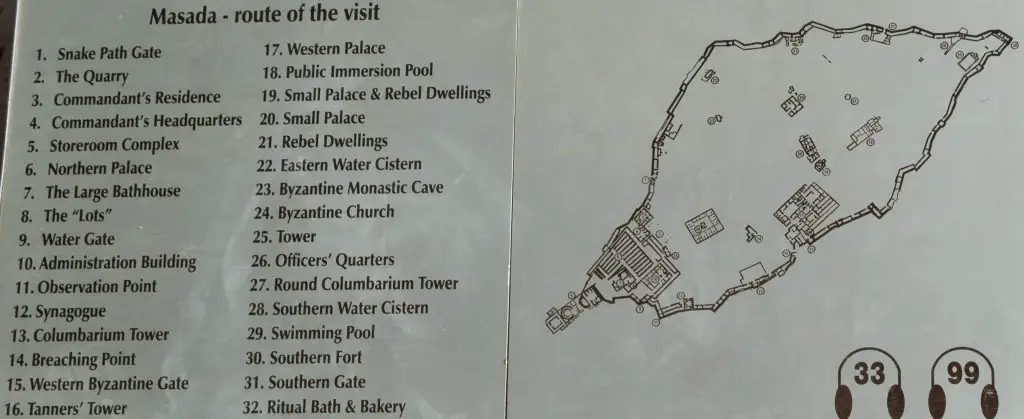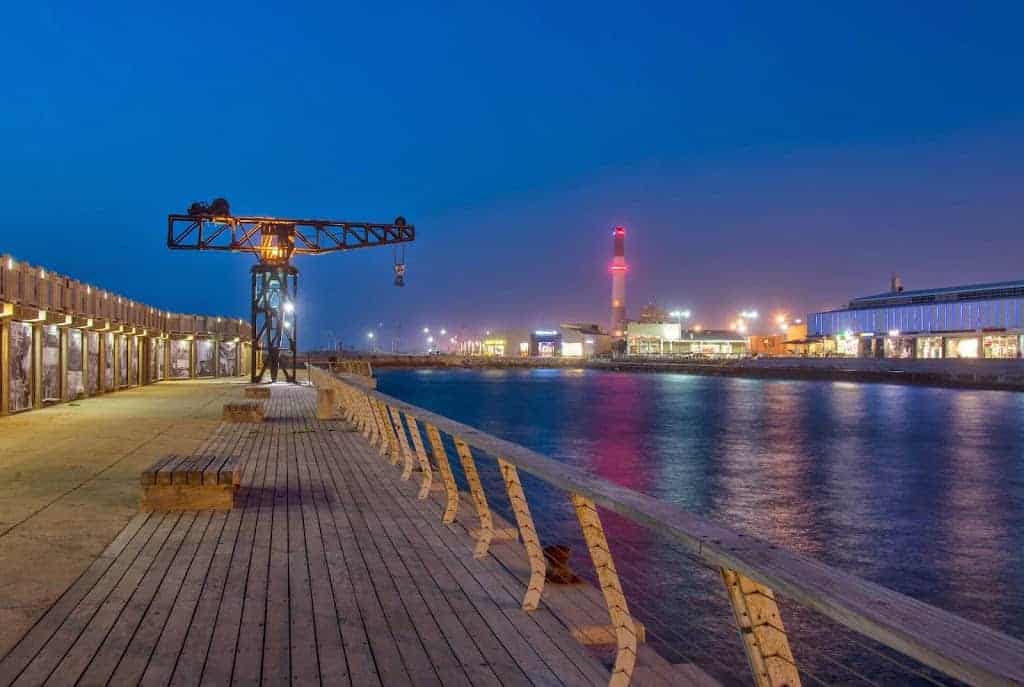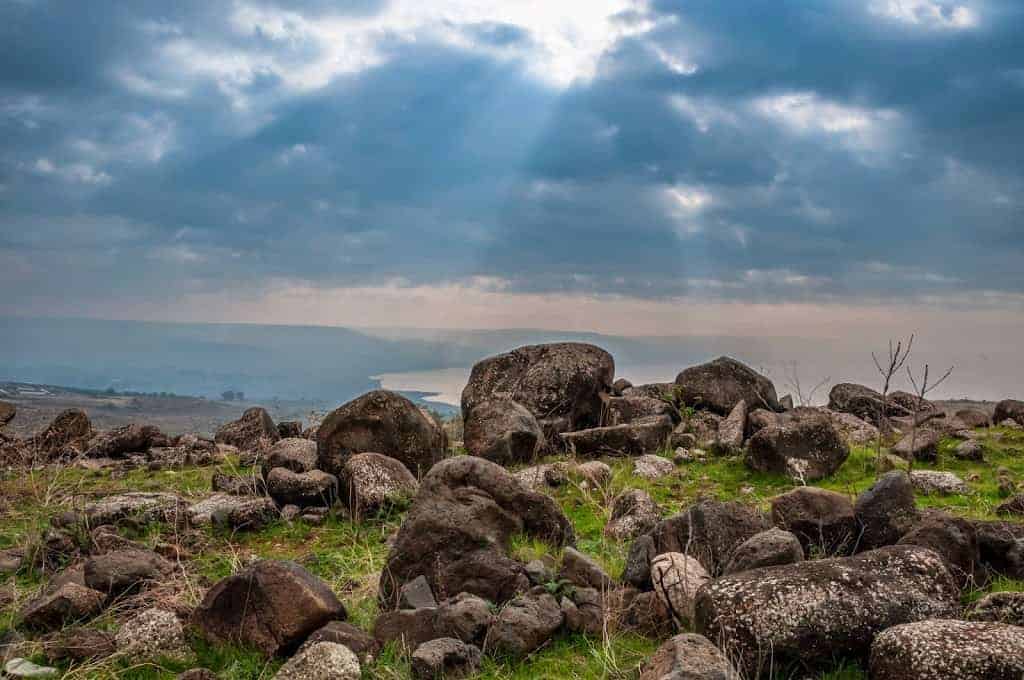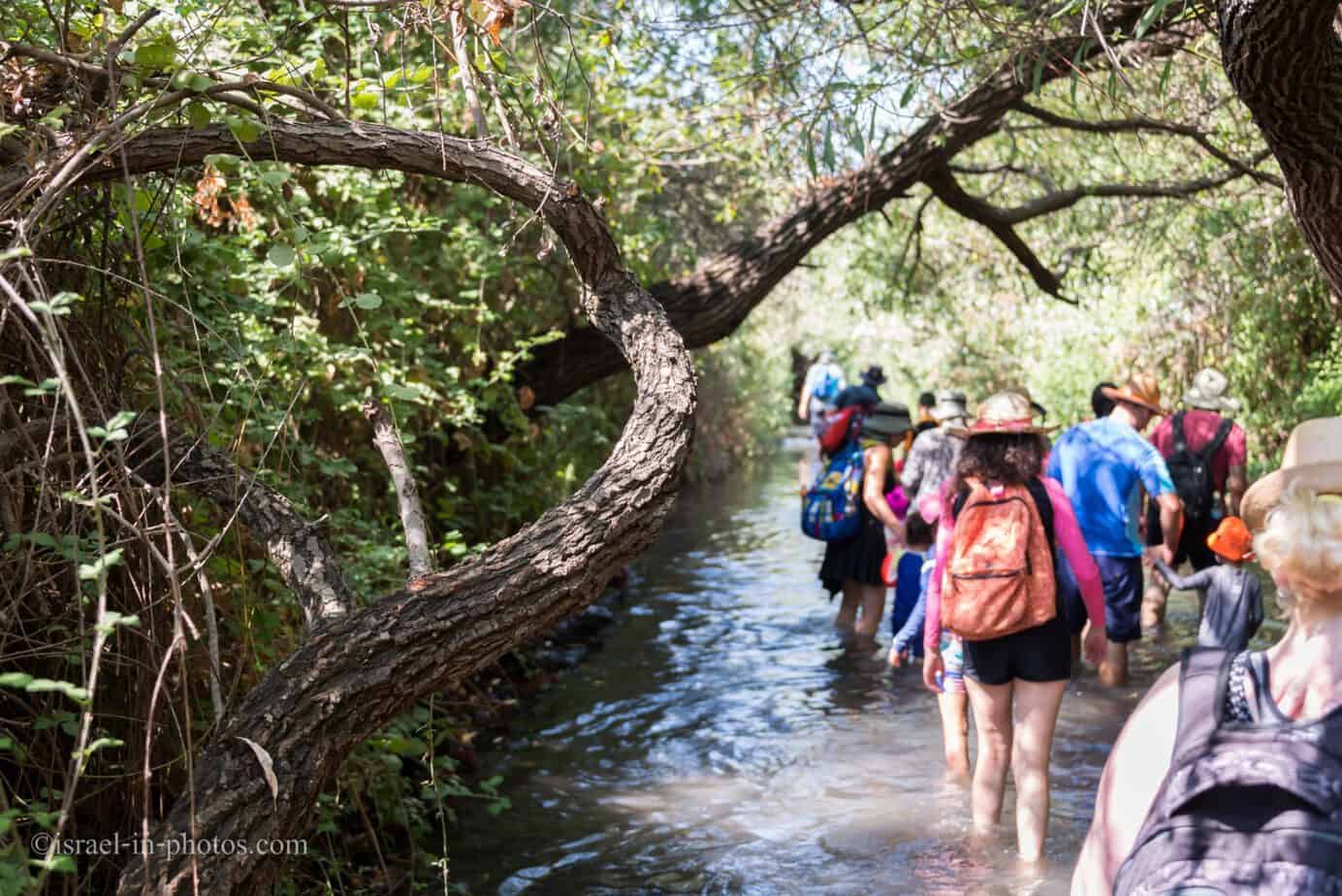גן לאומי מצדה – מדריך מבקרים עם מפה ותמונות
גן לאומי מצדה מספר את הסיפור יוצא הדופן של מצדה, מבצר עתיק במדבר יהודה ליד ים המלח.
הערה: המילה מצדה פירושה מבצר. ובשל המיקום שנבחר, זה היה מעוז.
תוכן עניינים
- 1 מפה
- 2 הוראות הגעה
- 3 מזג אוויר
- 4 שעות פתיחה
- 5 דמי כניסה
- 6 מופע לילה – מצדה משעות בין ערביים לשחר
- 7 רכבל
- 8 נתיב נחש מצדה
- 9 מצדה במקרא
- 10 סיורי זריחה מצדה
- 11 היסטוריה
- 12 מרכז מבקרים
- 13 שער שביל הנחש
- 14 בית המפקד
- 15 מתחם אחסון
- 16 הארמון הצפוני
- 17 בית המרחץ הגדול
- 18 ה- “גורלות”
- 19 חיות הבר
- 20 המגדל
- 21 מים במצדה
- 22 בית הכנסת
- 23 מגדל קולומבריום
- 24 המצור על מצדה
- 25 הארמון המערבי
- 26 כמה זמן לוקח ביקור במצדה?
- 27 חשיבותה של מצדה
- 28 שאלות נפוצות
- 29 סיכום
מפה
הגן הלאומי מצדה נמצא ליד ים המלח בין עין גדי ו- עין בוקק.
הערה: ישנן שתי כניסות. יש לבחור את הכניסה מראש ולוודא שאפליקציית הניווט מוגדרת כהלכה.
מפה אינטראקטיבית של האזור:
מפה מתוך החוברת:
הערה: ניתן ללחוץ על המפה בכדי להגדילה.
זכרו שמפה זו עלולה לבלבל מכיוון שהצפון מצביע למטה.
כפי שניתן לראות מן המפה, לפארק הלאומי הזה יש שתי כניסות. יתר על כן, אין כביש קרוב המחבר ביניהם. אם אתה רוצה לנסוע מכניסה אחת לאחרת, מדובר בכביש של כשבעים קילומטר שאורך כשעה. לכן, יש לבחור את הכניסה מראש ולוודא שאפליקציית הניווט מוגדרת כהלכה.
והנה המפה שמראה מה תוכלו למצוא בראש הרמה.
הערה: ניתן ללחוץ על המפה בכדי להגדילה.
הנה תקריב של תוכנית האתר.
ועכשיו, בואו נעבור על הכניסות ונבין אילו מתקנים יש לכל אחד. בנקודה זו, אזכיר שרוב המבקרים בוחרים בכניסה המזרחית.
הכניסה המערבית
ניתן להגיע אל הכניסה המערבית (בצד ימין של המפה) דרך הכביש #3199 מערד.
בכניסה זו יש חניה חינם ושירותים. כדאי להשתמש בכניסה זו אם אתם הולכים למופע הלילה (נקרא גם מופע הקול והאור).
אם אתם מתכוונים לטפס על מצדה (לא מתכננים להשתמש ברכבל) וחוששים מהקושי בטיול, אז אתה צריך לקחת את הכניסה הזו. הכניסה המערבית נמצאת בשטח גבוה יותר מזה המזרחי, והטיפוס הרבה יותר קל.
הכניסה המערבית בערך 20 מטר מתחת לפני הים. ראש הרמה מסביב 40 מטר מעל פני הים. זה אומר שהטיפוס כולו הוא 60 מטרים למעלה. סעו בשביל הרמפה של Siege כדי להגיע לשער המערבי ולמצדה. השלמת מסלול זה אורכת כרבע שעה בקצב מתון.
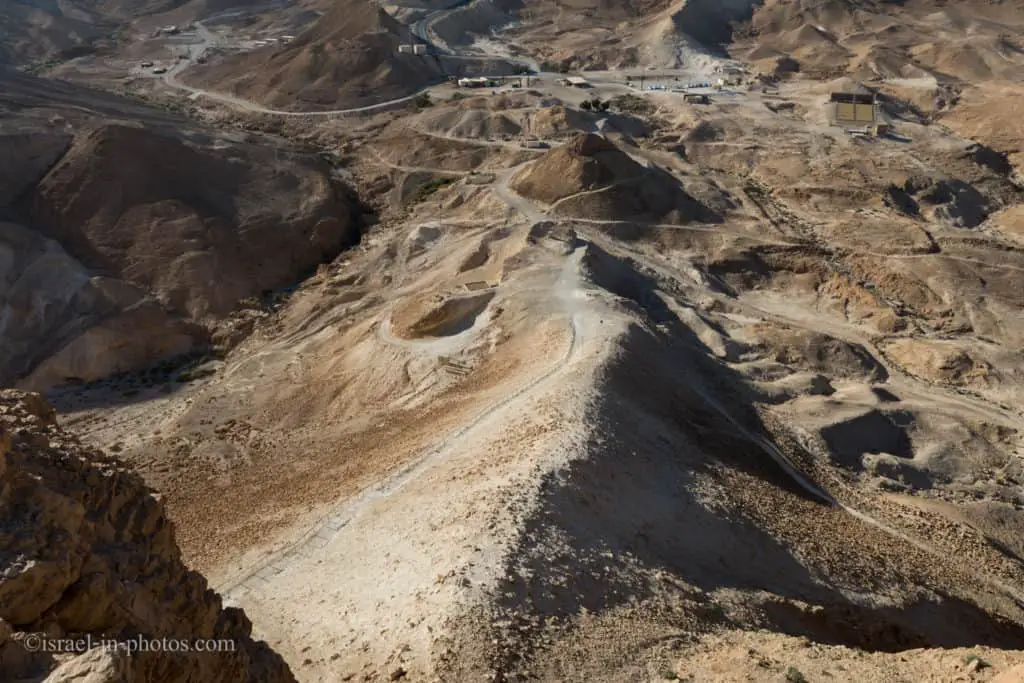
כמו כן, בכניסה המערבית, תוכלו למצוא את מגדל המצור ממצדה 1981 סדרות קטנות. עם זאת, יש לו רק את רמת הבסיס (במיני-סדרה, היו לו שלושה סיפורים).

קמפינג מצדה מערב
הקמפינג נמצא בסמוך לכניסה המערבית. הוא מציע תאורה, מזרקות מים לשתייה, אזור מנגלים, אזורי מדורה, שולחנות קבועים ומטלטלים, שקעי חשמל, ו-, כמובן, שירותים ומקלחות. פרטים נוספים זמינים כאן.
קרבתו של אתר הקמפינג הופכת אותו לנוח אם אתם שוקלים טיול זריחה או מופע לילה.
הכניסה המזרחית
הכניסה המזרחית היא העיקרית. הוא קרוב יותר לים המלח וניתן להגיע אליו באמצעות כביש #90.
בכניסה זו בנתה רשות הטבע והגנים מתחם שלם. במתחם זה, תוכלו למצוא את המוזיאון, בית קולנוע שמקרין סרט קצר על מצדה, לראות תערוכות שונות, אכול במסעדה, לבקר בחנות מזכרות, ואת השירותים. שיהיה ברור, חוץ מהשירותים, אין שום דבר בכניסה המערבית.
כי המתחם הזה מעשיר את הביקור שלכם, רוב האנשים בוחרים בזה. אבל יש לזה חיסרון. כפי שציינתי לעיל, הכניסה המזרחית נמצאת מתחת למערבון. לכן, הכניסה המזרחית ממוקמת בערך 270 מטר מתחת לפני הים. מכיוון שראש הרמה נמצא בסביבה 40 מטר מעל פני הים, זה אומר טיולים רגליים 310 מטר בעלייה. השביל הקצר והנפוץ ביותר הוא שביל הנחשים.
אבל לא צריך לטפס במעלה הגבעה. יש רכבל, ואתה יכול לרכוב עליו בתוספת תשלום. עיין בשני החלקים הבאים לפרטים אודות הרכבל ושביל הנחשים.
הוראות הגעה
אם אתם מגיעים ברכב, הזינו “גן לאומי מצדה” אל Waze או Google Maps, שייקח אותך לאחד החניונים החופשיים. אבל קחו בחשבון שיש שתי כניסות לפארק הלאומי הזה. אז וודא שאתה מגיע לזו הנדרשת.
במידה ואתם משתמשים בתחבורה ציבורית, אתם יכולים לקחת אוטובוס #486 מ- ירושלים לנווה זוהר ויציאה בתחנת האוטובוס מצדה. הנה הקישור המעודכן ל Moovit. הזינו את נקודת המוצא שלכם, ותקבלו את המסלול המעודכן.
מזג אוויר
הפארק הלאומי מצדה ממוקם במדבר. כלומר רותח באזור זה. יתר על כן, אחרי הגשם, קיימת סכנה של שיטפונות. לפיכך, אל תבקרו באזור ים המלח מספר ימים לאחר הגשם האחרון.
מתי לבקר במצדה?
בשל מזג האוויר, העונה הטובה ביותר לביקור היא אביב או סתיו (ולא אחרי גשם). יתר על כן, בקר בשעות הבוקר המוקדמות מכיוון שיהיה חם עד הצהריים. כמו כן, אם אתה מתכנן לטייל, אתה צריך לבוא מוקדם. יתר על כן, זכור את ההגבלות הבאות:
בימים חמים מאוד, עליית שביל הנחש נסגרת בשעה 09:00, והירידה נסגרת בשעה 10:00. כאשר החום הוא קיצוני, עליית שביל הנחש נסגרת בשעה 08:00, והירידה נסגרת בשעה 09:00. הירידה דרך הרמפה הרומית פתוחה כרגיל.
הערה: אלא אם כן צוין אחרת, כל הציטוטים נלקחו מתוךהאתר הרשמי.
ותמיד קחו כובעים, קרם הגנה, והרבה מים.
שעות פתיחה
ראשון - חמישי ושבת: 8:00 – 17:00 (16:00 בחורף).
שישי: 8:00 – 16:00 (15:00 בחורף).
בערבי חג, בדרך כלל 8:00 – 13:00.
הערה: מאז המגיפה, רשות הטבע והגנים החלה להגביל את מספר האנשים בכל פארק. לכן, מומלץ להזמין מקומות דרך האתר הרשמי (תוכלו למצוא את הקישור למטה).
שביל הנחש נפתח לעלייה בכל יום שעה לפני הזריחה ונסגר לירידה שעה לפני שעת הסגירה.
שביל הרמפה הרומי נפתח לעלות כל יום חצי שעה לפני הזריחה ונסגר לירידה 15 דקות לפני זמן הסגירה.
דמי כניסה
עלות הכניסה לפארק הלאומי מצדה 31 שקל למבוגר, 17 שקל לילד, ו- 26 שקל לתלמיד. וללא תשלום עבור מנויים של הגנים הלאומיים.
מעבר לדמי הכניסה, ייתכן שתחליט לבקר במוזיאון. וזה יעלה תוספת 20 שקל לאדם.
יתר על כן, אתה חייב לשלם תוספת כדי לעלות ברכבל. עלויות הרכבל החד כיווני 28 שקל למבוגר ו- 14 שקל לילד, ועלות הלוך ושוב 46 שקל למבוגר ו- 28 שקל לילד.
ונעבור על מחירי מופע הלילה בחלק הבא.
אם אתם מבקרים במספר פארקים לאומיים, אז כדאי לשקול רכישת כרטיס משולב. ניתן למצוא מידע נוסף ב-גנים לאומיים ושמורות טבע.
הערה: שעות הפתיחה ומחירי הכרטיסים עודכנו בחודש מאי 2022. בכל מקרה, בדקו מחדש אתהאתר הרשמי לפני הביקור.
מופע לילה – מצדה משעות בין ערביים לשחר
מופע הלילה החדש מוקרן במדרון המערבי של ההר, בין הרמפה לארמון הצפוני. הוא כולל טכנולוגיית מיפוי וידאו באחת מהתוכניות הגדולות מסוג זה שנוצרו אי פעם בישראל ואפקטים מיוחדים של תאורה. את הפסקול המרגש הלחין במיוחד שלמה גרוניך, עם הרבה סולנים, כולל הראל סאקט ולירז צ'ארי, תזמורת מעוררת ומקהלה - כולם נושמים חיים חדשים בסאגת מצדה וגיבוריה.
מקור: אתר רשמי
מופע לילה – מידע בסיסי
המופע מתקיים ביום שלישי וחמישי לאחר השקיעה, ב 19: 30 במהלך החורף ו 20: 30 או 21: 00 בקיץ.
מחיר הכניסה הוא 50 שקל למבוגר ו- 40 ש"ח לילד (גילאים 5-18).
הנחות זמינות לקבוצות, חברי מועדון מטמון ואורחים לילה בקמפינג מצדה מערב.
ההצגה היא 45 דקות, והוא מומלץ לילדים מעל גיל עשר.
הזינו “אתר מצדה מערב” ל-Waze כדי להגיע להופעה. וזה ייקח אותך דרך ערה.
רכבל
מכיוון שיש הרבה שאלות לגבי הרכבל, החלטתי להוסיף קטע ייעודי.
אם בחרתם בכניסה המזרחית, ישנן שתי דרכים נפוצות להגיע לפסגה. השתמש בנתיב הנחש או סע ברכבל. הרכבל כרוך בתשלום נוסף (ראה סעיף עלות כניסה), מקצר משמעותית את הזמן שלוקח מהכניסה לראש הרמה.

הנסיעה נמשכת 3 – 4 דקות, והרכבל חלק.
הרכבל - מהכניסה המזרחית, יש רכבל עד שער נתיבי הנחש בראש ההר. הרכבל המודרני מחליף את הרכבל הישן של שנות השבעים ומשתלב טוב יותר ופחות פולשני עם הסביבה. הרכבל הישן הותקן ב 1971, נושא מספר מצומצם של מבקרים לנקודה הנמוכה ביותר על ראש הגבעה, ממנה המשיכו בעלייתם למעלה במדרגות. ב- 1998 מערכת הרכבלים הוחלפה כדי לעמוד בדרישות של מספר הגדל של מבקרים באתר. תחנת הרכבל התחתונה נבנתה למרגלות ההר, הופכים לחלק ממתחם מרכז המבקרים. המדרגות בתחנה העליונה הוסרו, והכניסה למצודה היום היא דרך גשר תלוי, מה שמאפשר גישה גם לאנשים עם מוגבלות.
והנה תמונה שצילמתי כשהגענו כמעט לפסגה.

נתיב נחש מצדה
כפי שציינתי לעיל, שביל הנחשים הוא דרך נפוצה להגיע למצדה מהכניסה המזרחית (השיטה הנפוצה הנוספת היא הרכבל).
שביל נחשי מצדה אורכו כשני קילומטרים ומטפס בערך 310 מטר בעלייה. זה משלב עלייה בעלייה עם טיפוס של כמה מדרגות.

הערה: אתה יכול לראות נקודות קטנות בתחתית התמונה למעלה. אלה אנשים המטפסים.
כפי שניתן לראות, קל לניווט, ואתה לא צריך שום מפות או ניסיון טיול. אבל עדיף שיהיו לך נעליים נוחות והרבה מים (לפחות שני ליטר לאדם).
שביל הנחש אורך כשעה. אם אתה לא בכושר, אז זה עשוי לקחת יותר. עם זאת, זה תלוי לא רק ברמת הכושר שלך אלא גם במזג האוויר. יתר על כן, בימים סוחפים, הם י סגור את נתיב הנחש עלייה. ראו את פרק מזג האוויר למעלה.
ואני רוצה לסיים את החלק הזה בשאלה שמתעלמים ממנה לרוב.
האם כדאי לקחת את נתיב הנחש?
לדעתי, התשובה היא לא (אם רכישת כרטיס לרכבל אינה בעיה).
היתרונות הם שלקחת את דרך הנחש תחסוך לך כסף, ותרגיש מימוש עצמי לאחר שתשלים אותה. אבל את האחרון אפשר לומר על השלמת כל מסלול מאתגר.
החסרונות הם הזמן הנוסף שהושקע. יתר על כן, אין נקודות עניין בדרך, והנופים שבראש מישור מצדה טובים בכל מקרה. או, שים בקצרה, הטיול עשוי להיות מאתגר אך משעמם. יתר על כן, אתה עלול להיות עייף עד שתגיע לפסגה, כך שתדלג על חלקים של מצדה.
לכן, אם כסף (לרכבל) אינו נושא, אני מציע לרכוש כרטיסים לרכבל (או להשתמש בכניסה המערבית). אתה יכול גם לנצל את הזמן שאתה חוסך כדי לטייל במקום עם נקודות עניין בדרך, כמו שמורת טבע עין גדי.
מצדה במקרא
מצדה אינה מוזכרת במקרא בשמה. אבל אם נזכור שמצדה פירושה מבצר או מעוז, ניתן להתייחס אליו תחת השם הזה.
יתכן שזה היה מקלטו של דייוויד במהלך בריחתו מסול ושם כתב כמה מזמורי תהילים. אם כך, דוד התייחס ככל הנראה למצדה כ"מעוז" (שמואל 1 22:4-5, 23:14, 24:22), משתמש בו כדי לתאר את אלוהים כמבצרו וכסלע מקלטו (תהילים 18:2, 31, 71:3, 144:2).
מקור: land-of-the-ible.com
סיורי זריחה מצדה
כפי שראית למעלה, נתיב הנחש ושביל הרמפה הרומי פתוחים לעלייה כל יום לפני הזריחה. אנשים רבים בוחרים לראות את הזריחה במצדה.
יתר על כן, חברות טיולים רבות מציעות סיורי מצדה זריחה מעבר לנסיעות רגילות. סיור זריחה יכול להיות מועיל מכיוון שרואים דברים רבים ביום אחד (מאחר שמתחילים מוקדם). אז קחו בחשבון אפשרות זו.
היסטוריה
להלן התמצית ההיסטורית מהעלון הרשמי.
מקורות
סיפור מצדה תועד על ידי יוספוס פלביוס, שהיה מפקד הגליל במהלך המרד הגדול ובהמשך נכנע לרומאים ביודפת. בזמן כיבוש מצדה, הוא היה ברומא, שם התמסר לכריתת המרד. למרות הוויכוח סביב דיוק חשבונותיו, נראה שתכונותיו העיקריות נולדו בחפירה.
התקופה החשמונאית
על פי יוסף בן מתתיהו, המצודה הראשונה במצדה הוקמה על ידי “יונתן הכהן הגדול” - ככל הנראה, המלך החשמונאי אלכסנדר ינאיוס (103-76 לפני הספירה). המטבעות שלהם התגלו בחפירות האתר.
ישנם חוקרים הנוטים לזהות את ג'ונתן עם אחיו של יהודה המכבי, שהפך לכהן גדול ב 152 לפנה"ס. עד כה, במצדה לא התגלו שרידים ארכיטקטוניים שניתן לתארך בוודאות לתקופת החשמונאים.
התקופה ההרודיאנית
הורדוס, ששלט מ 37 לפני הספירה 4 לפנה"ס, היה מודע היטב ליתרונות האסטרטגיים של מצדה. הוא, ולכן, בחר באתר כמפלט נגד אויביו וכארמון חורף. במהלך שלטונו, כאן נבנו ארמונות מפוארים בנוסף למחסנים מצוידים, בורות מים, וקיר סיד. לאחר מות הורדוס ב 4 לפני הספירה וסיפוח יהודה לאימפריה הרומית בשנת 6 לספירה, הרומאים הציבו חיל מצב במצדה.
המרד הגדול
יוספוס מספר כי אחד האירועים הראשונים של המרד הגדול של היהודים נגד הרומאים, שפרצה פנימה 66 לספירה, הייתה כיבוש מצדה על ידי הסיצרים, קבוצה שקיבלה את שמה מפגיון מעוקל, הסיקה, שהם נשאו. בראש הסיצרים עמד מנחם, בן יהודה הגלילי, שנרצח בירושלים ב 66 לספירה. אחרי הרצח, אלעזר בן יאיר נמלט מירושלים למצדה והפך למפקד קהילת המורדים בהר. זו הייתה קבוצה מגוונת, שכולל ככל הנראה אסיים ושומרונים. אחרון המורדים ברחו למצדה לאחר חורבן ירושלים בעיר 70 לספירה הצטרפו לאלה שכבר היו במצודה בפיקודו של אלעזר בן יאיר.
המורדים, שהתגוררו בחדרים בקיר הקזמט ובחלק מארמונות הורדוס, הקים בית כנסת ומקוואות (מקוואות יהדות). הם השאירו אחריהם שרידים חומריים רבים המעידים על חיי הקהילה שלהם.
המצור
על פי יוסף בן מתתיהו, מצדה הייתה מעוז המורדים האחרון ביהודה. ב- 73 או 74 לספירה, הלגיון העשירי הרומאי פרטנסיס, בראשות פלביוס סילבה, הטיל מצור להר. הלגיון, המורכב 8,000 כוחות שביניהם היו כוחות עזר, בנו שמונה מחנות סביב הבסיס, קיר מצור, ורמפה עשויה אדמה ותומכי עץ במדרון טבעי מערבה. יהודים בשבויים הביאו מים לחיילים, כנראה מעין גדי, כמו גם אוכל.
לאחר מצור שנמשך מספר חודשים, הרומאים הביאו מגדל עם איל מוכה במעלה הרמפה איתם החלו לעטוף את החומה. המורדים בנו קיר תומך פנימי מעץ ואדמה, שהרומאים הציתו אז. יוספוס תיאר זאת כאשר תקוות המורדים דעכה, אלעזר בן יאיר נשא שני נאומים בהם שכנע את מנהיגי הוועדה 960 חברי הקהילה שעדיף לקחת את חייהם ואת חייהם של משפחותיהם מאשר לחיות בבושה והשפלה כעבדים רומיים. ביוסף בן מתתיהו’ מילים משלו:
“לאחר מכן, לאחר שבחרו בהרבה עשר ממספרם כדי לשלוח את השאר, הם הניחו את עצמם כל אחד ליד אשתו והילדים החסונים שלו, ו-, מסובבים את זרועותיהם סביבם, הציעו את גרונם במוכנות למנהלי המשרד המלנכולי. אלה, לאחר ששחט ללא כוונה את כולם, הוסמך זהה למגרש זה לזה, שהוא על זה הוא נפל צריך להרוג תחילה את התשעה ואחר כך את עצמו אחרון מכל: ... הם מתו מתוך אמונה שלא השאירו נפש מהם בחיים ליפול לידיים רומיות; הרומאים התקדמו למתקפה ... לא ראו אף אחד מהאויבים אלא מכל הצדדים בדידות נוראה, ולהבות בפנים ושקט, הם הפסידו להעלות על הדעת מה שקרה כאן במפגש ההמונים, במקום לשמוח כמו על אויבים, הם העריצו את האצולה של נחישותם ואת הזלזול במוות של רבים כל כך בסחיבתם, לא מתרחש, להוצאה להורג.”
(יוספוס פלביוס, מלחמות היהודים, VII, 395-406):
על פי יוסף בן מתתיהו, שתי נשים וחמישה ילדים שהסתתרו בבורות מים על פסגת ההר, סיפרו לרומאים מה קרה באותו לילה, ב -15 בניסן, היום הראשון של חג הפסח.
נפילת מצדה הייתה המעשה האחרון בכיבוש רומא את יהודה. יחידת עזר רומאית נותרה במקום עד תחילת המאה השנייה לספירה.
התקופה הביזנטית
לאחר שהרומאים עזבו את מצדה, המצודה נותרה מיושבת במשך כמה מאות שנים. במהלך המאה החמישית לספירה, בתקופה הביזנטית, מנזר מהסוג המכונה לורה, מיושב על ידי נזירים, נוסד. חוקרים אחדים מזהים את מנזר מצדה עם אתר בשם מרדה, שהוזכרו על ידי אבות הכנסייה. עם עליית האיסלאם במאה השביעית, המנזר ככל הנראה חדל להתקיים.
תולדות מחקר מצדה
לאחר התקופה הביזנטית, מצדה שקעה בתהום הנשייה עד המאה התשע עשרה. המלומדים הראשונים שזיהו את מצדה עם הרמה המכונה בערבית es-Sebbeh היו סמית ורובינסון ב 1838, והראשונים שטיפסו עליו היו וולקוט והטיפינג פנימה 1842. וורן טיפס על מצדה פנימה 1867, קונדר תיאר אותה ומיפתה אותה 1875, סנדל גילה את מערכת המים ב 1905, ושולטן חקר בעיקר את מערכת המצור הרומית ב 1932.
משנות העשרים ובעיקר בשנות הארבעים, מצדה הפכה לאבן יסוד לקבוצות נוער ציוניות חלוציות. התרגום לעברית ב 1923 של מלחמות היהודים מאת יוספוס, כמו גם השיר “מצדה,” נכתב על ידי למדן, פורסם ב 1927, קירבה את מצדה לליבם של צעירים בקהילה היהודית במדינה. שמריה גוטמן, שהוביל טיולים רבים להר, היה חשוב במיוחד בהפיכת מצדה לסמל. יחד עם מיכה ליבנה וזאב משל, גוטמן גילה מחדש את ארמון הצפון ואת שביל הנחש 1953. חפירות סקר נערכו בשנים 1955–1956, בעיקר בחלק הצפוני של הרמה ומערכת המים. זה הוביל לחפירות הגדולות שביצע האוניברסיטה העברית בירושלים, בראשות יגאל ידין מ 1963 ל- 1965. חפירות אלה חשפו את מרבית מבני מצדה, יחד עם אלפי ממצאים שמורים היטב המציגים תמונה נדירה של התרבות החומרית בסוף ימי הבית השני.
במהלך החפירות, מבנים רבים השתמרו ושוחזרו, ולאחר הכנת האתר למבקרים, הפארק הלאומי מצדה נפתח ב 1966. הקמת הרכבל הראשון ב 1971 הגדיל את זרם המבקרים.
לאחר חפירה קצרה ב 1989 בניצוחו של אהוד נצר, חפירות חודשו על ידי האוניברסיטה העברית ב- 1995 במסגרת פרויקט פיתוח רחב היקף במימון משרד התיירות באמצעות חברת התיירות הממשלתית. מספר עונות חפירה בוצעו בהובלתם של אהוד נצר וגיא שטיבל על הרמה, בנוסף לעונה שביים גדעון פרסטר במחנה הרומי F ורמפת המצור.
פעילויות שימור ושיקום בוצעו על ידי רשות הטבע והגנים.
מרכז מבקרים
לאחר כיסוי כל היסודות, בואו לבקר במצדה. נתחיל במרכז המבקרים בכניסה המזרחית.
לאחר רכישת הכרטיסים, צפינו בסרט קצר על מצדה ואז בדקנו את התערוכות בבניין הזה. לדוגמה, הנה הקשר גיאוגרפי והיסטורי.



יש גם הרבה ציור. הנה אחד שמראה את המחנות הרומאים סביב מצדה.
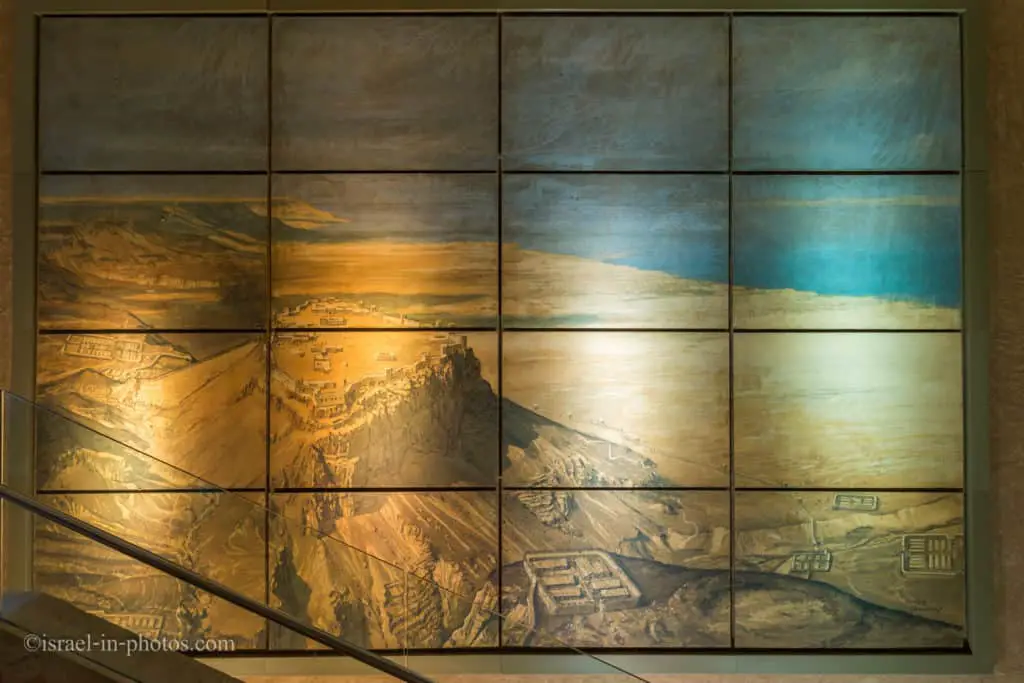
מוזיאון מצדה
מכיוון שרכשנו כרטיסים למוזיאון, שמנו פעמינו לשם.
מוזיאון מצדה - מוזיאון יגאל ידין מאזדה פתוח מאז 2007. ביקור במוזיאון יכול לכלול גם חוויה תיאטרלית וסיפור רדיו, נותן למבקרים את הרקע וקביעת הסצינה לפני שהם מבקרים באתר עצמו.
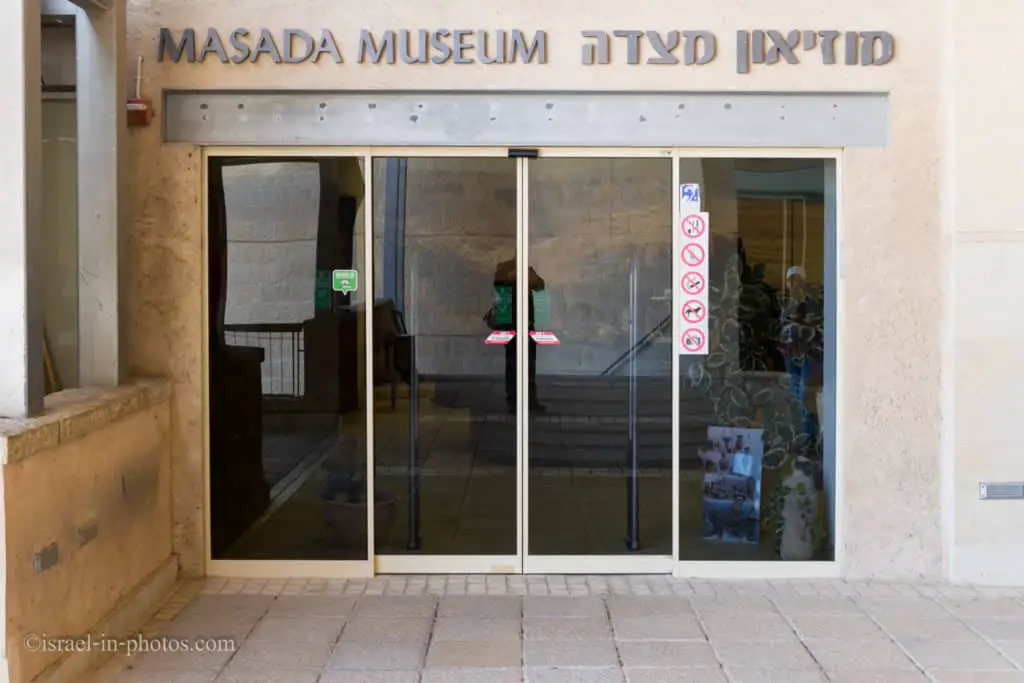
צילום בתוך המוזיאון אסור. לכן, אין לי תמונות להראות. אבל אני יכול להגיד לך למה לצפות.
בכניסה, לכל אחד מאיתנו יש מדריך שמע, שהיה זמין במגוון שפות. לאחר מכן, התחלנו לסייר בחדרי המוזיאון. כל חדר מוקדש לתקופה או לאירוע, והמדריך האודיו מספר על המוצגים’ סיפור יחד עם המוצגים.
המוזיאון לא גדול. הביקור בכל התערוכות אורך כחצי שעה.
כשסיימנו במוזיאון, פנינו לרכבל.
שער שביל הנחש
נקודת עניין #1 הוא שער שביל הנחש.

אתה יכול לראות שער זה בפינה השמאלית העליונה של התמונה למעלה.
אם אתה עוקב אחר המספרים, המסלול בראש הרמה מעגלי בערך, בכיוון נגד כיוון השעון (ראה סעיף תוכנית האתר למעלה למידע נוסף).
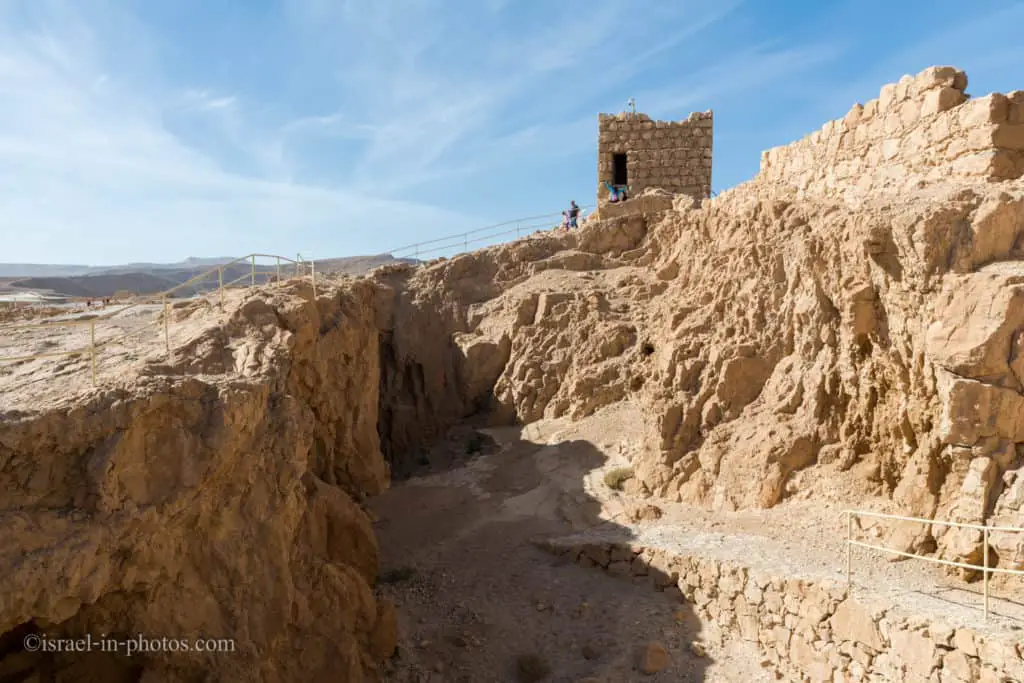
במדריך זה, לא נעבור על כל נקודות העניין. במקום זה, נבחן את המשמעותיים ביותר שבהם.
בית המפקד
לשכת המפקד (נקודת עניין #3) ומטה המפקד (נקודת עניין #4) נמצאים ליד שער נתיב הנחש.

לשכת המפקד - לשכת המפקד, ליד שער נתיב הנחש, בנוי כסדרת חדרים מעוטרים בציורי קיר (ציורי קיר שנעשו על טיח לח). רוב הקישוטים הם דפוסים גיאומטריים ושיש חיקוי, בעוד שאחרים עיצובים פרחוניים.

למפקדת המפקד יש מיקום אסטרטגי. מצד אחד, זה קרוב לכניסה. זה שימושי עבור בקרת סחר והגנה. ובצד השני, הוא קרוב לבניינים חיוניים בתוך מצדה, כמו הארמון הצפוני ומתחם המחסן.
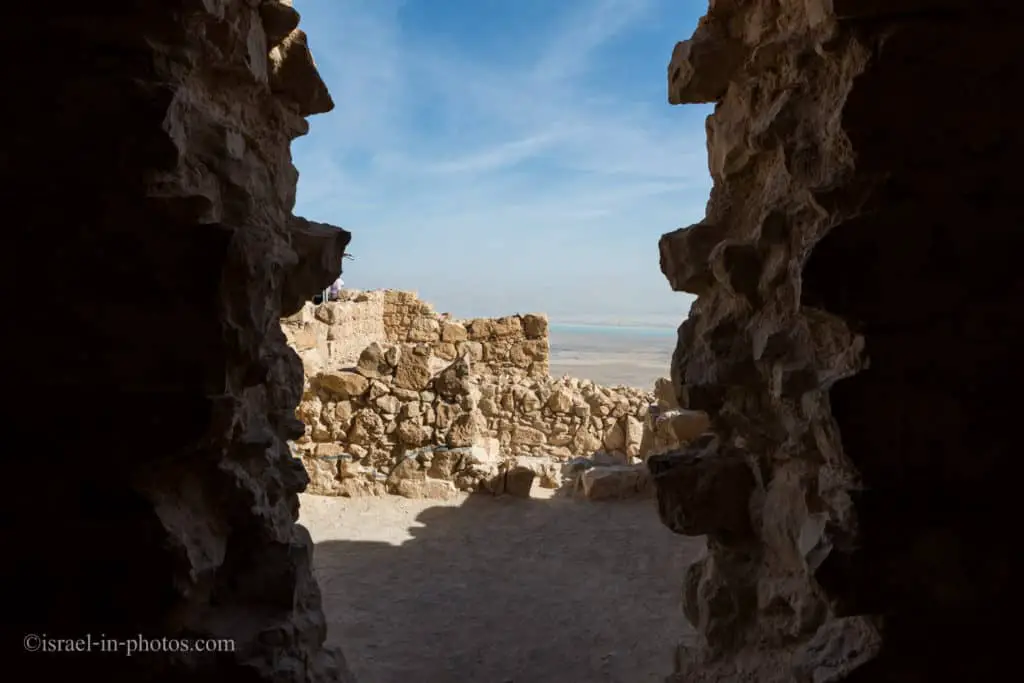

מתחם אחסון
לשרוד באתר מרוחק במדבר, עליך לאחסן סחורות רבות (נקודת עניין #5 על המפה).
“אבל החנויות שהוצבו בפנים היו מעוררות פליאה עוד יותר. שכן כאן אוחסנה המוני תירס, מספיק כדי להחזיק מעמד במשך שנים, שפע של יין ושמן, מלבד כל מגוון הדופק וערימות התמרים.”
יוספוס פלביוס
עד היום סוד ההישרדות במצב חירום במיקום מדברי מבודד ונידח זה נותר שאלה מסקרנת. אחת התשובות היא מתחם המחסנים העצום, נבנה במהלך בניית מצדה. כאן אוחסנו המזון הדרוש לקיום על ההר בימי הורדוס והמצור הרומי. מכל מצודות המדבר, מצדה הייתה הכי מוכנה למצור ממושך על מספר גדול של תושבים. זה ברור מהמחסנים הרבים בהר, מאורגן על פי תוכנם, עם נוזלים ומזון המאוחסן בנפרד. על פי יוסף בן מתתיהו, המחסנים כללו אגף מיוחד לאחסון כמויות גדולות של כלי נשק וחומרי הגלם לייצורם. הנשק נלקח לירושלים במהלך המרד.
מקור: שלט
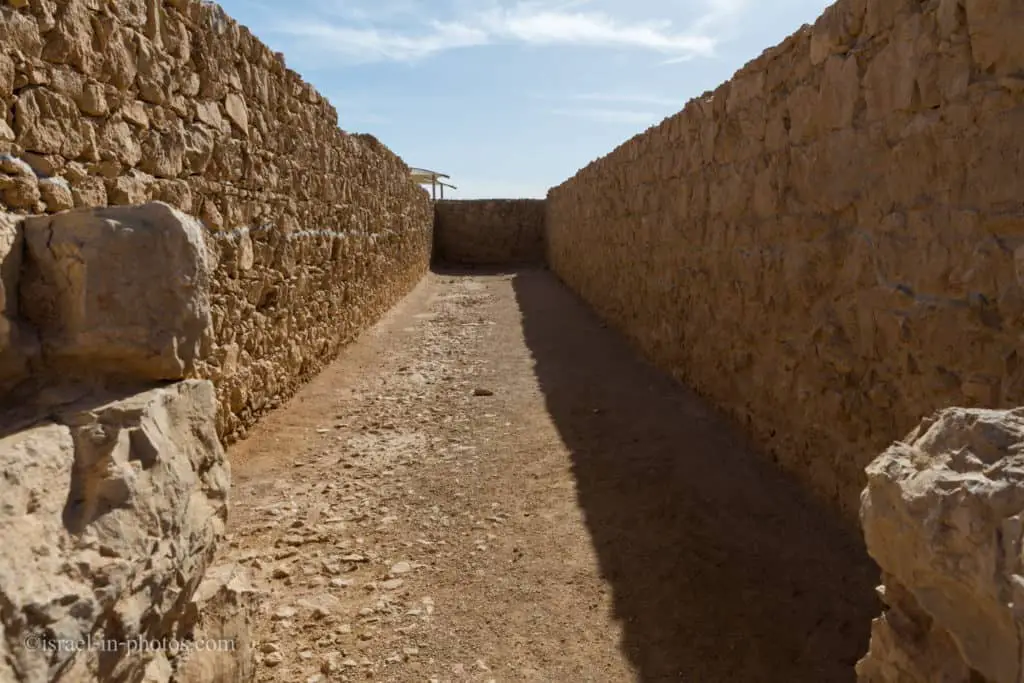
הארמון הצפוני
בכל פעם שאתה רואה תמונה של מצדה, סביר להניח שבארמון הצפוני (נקודת עניין #6 על המפה). וזה לא במקרה. רבים מכנים את הארמון הצפוני כאחד המבנים הנועזים ביותר שנבנה על ידי המלך הורדוס ופנינה אדריכלית.
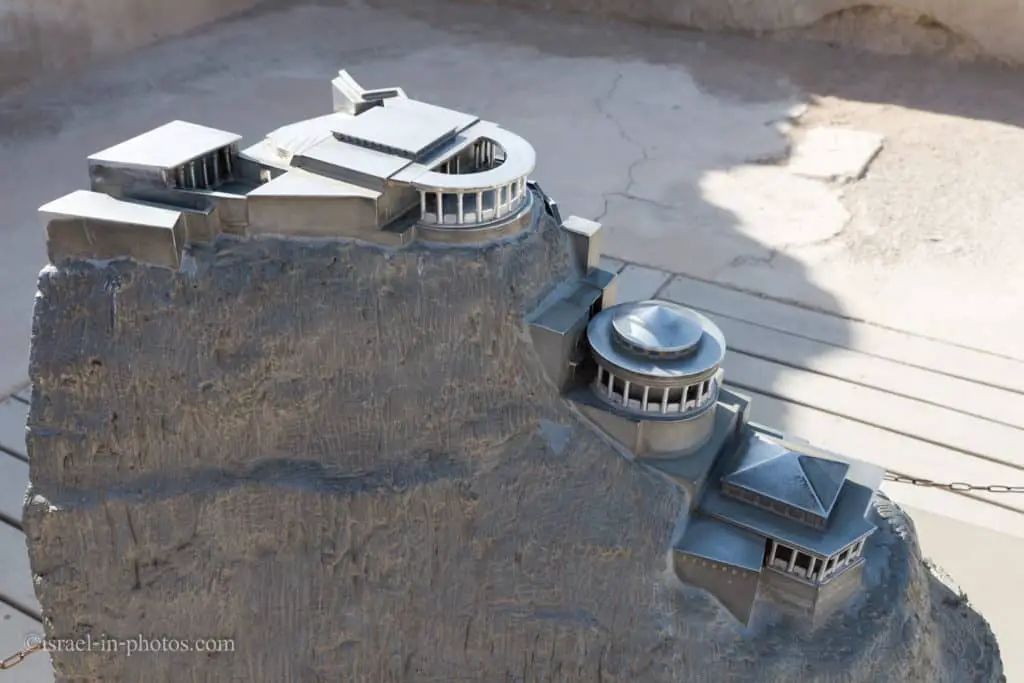
הארמון הצפוני הוקם באומץ על ראש הגבעה, מעבר לתהום. הארמון בנוי על שלוש טרסות סלע, עם הפרש גובה כולל של כמה 30 מ, ודורש קירות תמך חזקים.
הארמון מראה השפעה ארכיטקטונית הלניסטית ורומית. במרפסת העליונה היו החדרים הפרטיים של הורדוס, אגף מגורים עם ארבעה חדרים ואולם מרכזי. החדרים היו מרוצפים בעיצובים פסיפס גיאומטריים, וציורי קיר צבעו על הקירות. רצפת הפסיפס של החדר הדרום-מערבי השתמרה, בדוגמת משושים שחור לבן. זהו עיצוב נפוץ ברומא וסביבתה, וקיומו כאן עשוי להוות עדות למקורם של האמנים שיצרו אותו.
בארמון הצפון שלוש דרגות. מתחילים מלמעלה ומגיעים למטה ליד המדרגות.
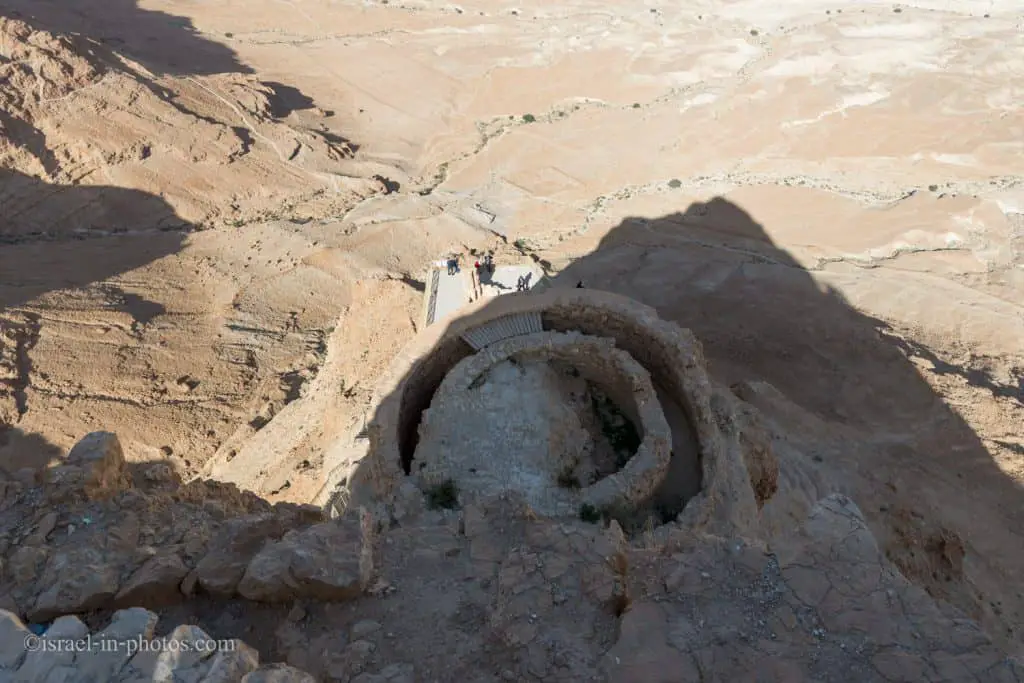
בחוץ פטיו חצי עיגול, מוקף בעבר בעמודים, שמשקיף על ההי’ צוק אטקים במדבר יהודה, ים המלח, ומערך המצור הרומי. במרכז המרפסת האמצעית היה אולם מעגלי מוקף בעמודים, מהם נותרו רק היסודות. זה היה אולם הקבלה והאירועים.
בארמון היה גם בית מרחץ קטן, ובו נמצאו שרידי השלד של מה שמוערך כשלושה מהמורדים, כמו גם שיער קלוע של אישה, השתמר להפליא.
המרפסת התחתונה של הארמון הצפוני
אז נדלג על מספר נקודות עניין (נחזור אליהן מאוחר) ונבקר במרפסת התחתונה של הארמון הצפוני.
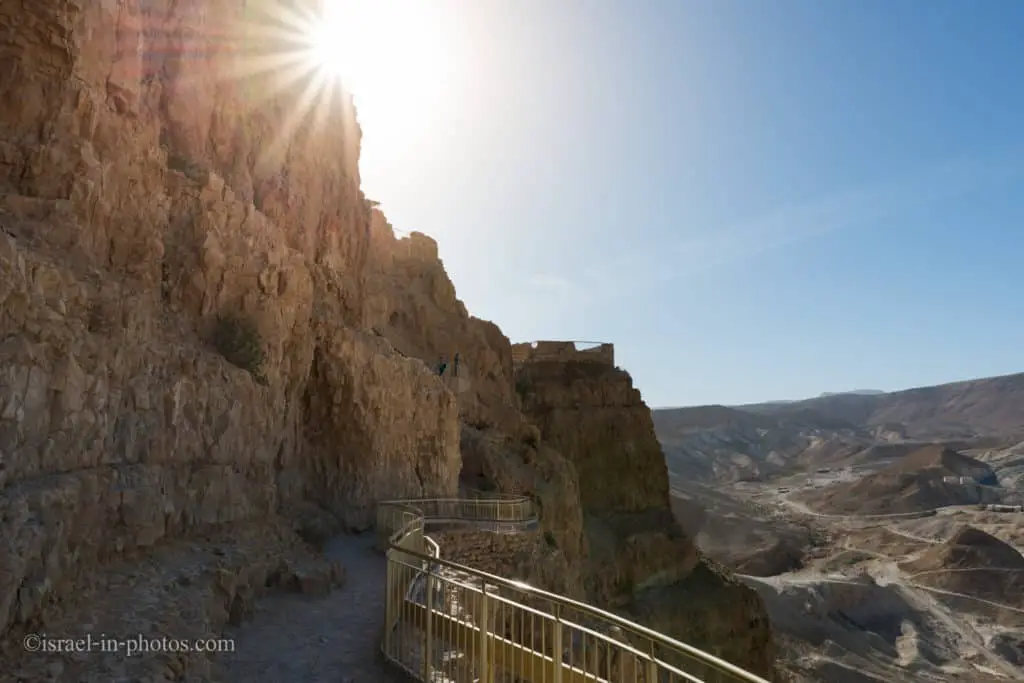
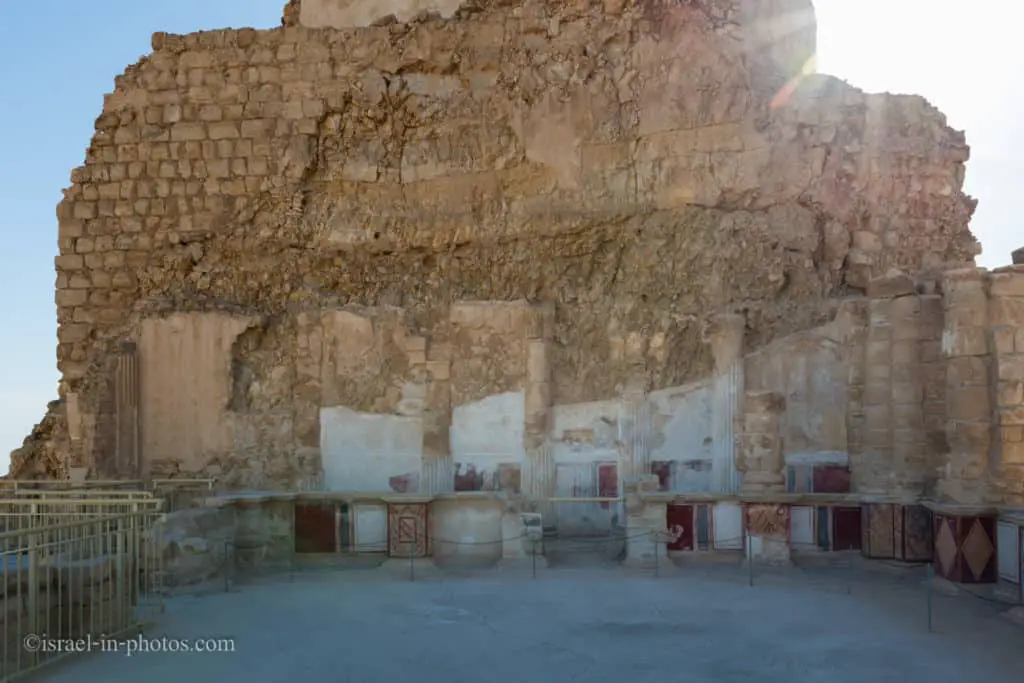
המרפסת התחתונה החזיקה גם אולם, מוקף עמודים. הקירות החיצוניים של האולם היו מעוטרים בעיצובי טיח, והקירות הפנימיים - עם ציורי קיר (ציורי קיר שצוירו על טיח לח) המתארים לוחות שיש חיקוי צבעוניים ועיצובים גיאומטריים..
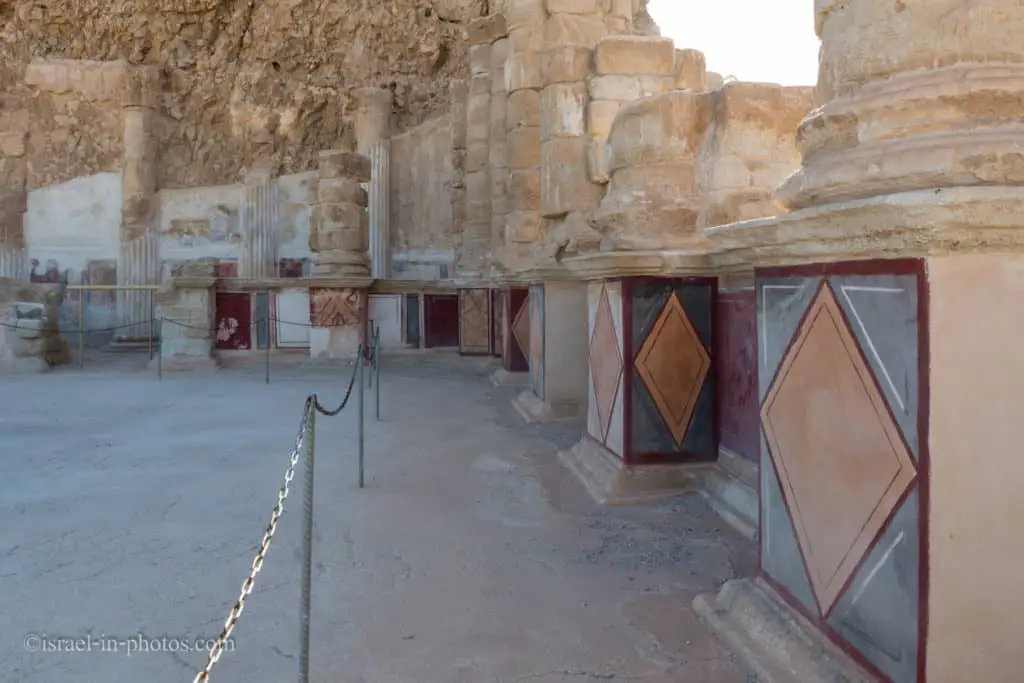
והארמון הצפוני מציע נוף מדהים, אז זהו מקום חובה לסלפי;)
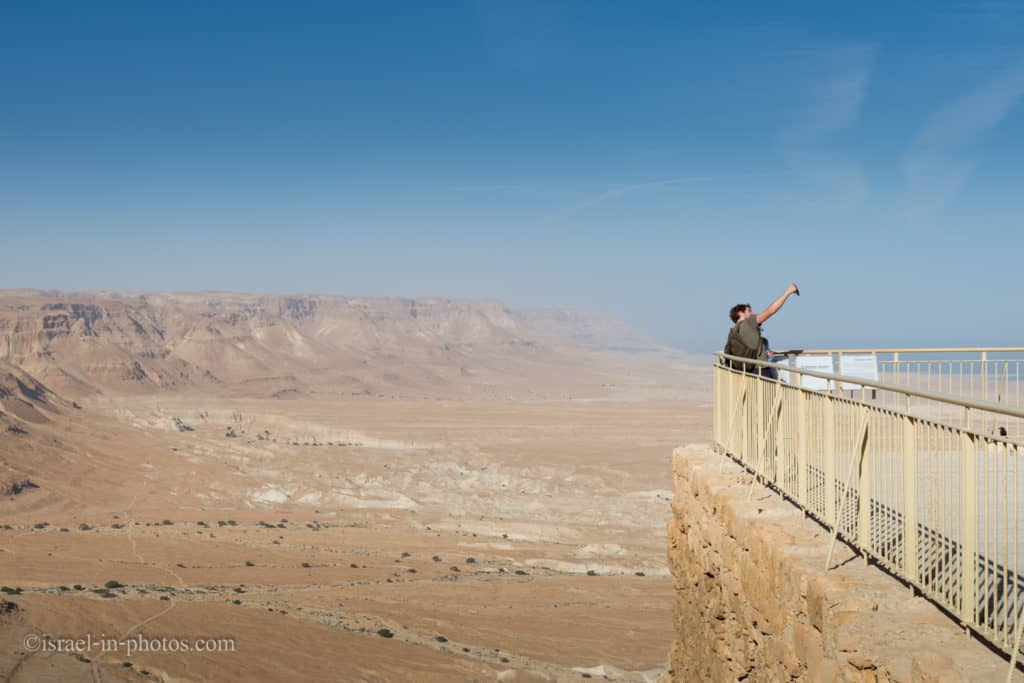
הנה מבט רחב של המערב. הכניסה המערבית נראית לעין, עם שביל הרמפה הרומי משמאל ושרידי מחנה רומי מימין.

ועכשיו, בואו נחזור למפלס העליון של בית המרחץ הגדול.
בית המרחץ הגדול
בית המרחץ הגדול (נקודת עניין #7 על המפה) הוא בית מרחץ בסגנון רומאי.
בכניסה חצר מוקפת עמודים, מיועד לאימוני התעמלות. חדר ההלבשה (אפודיטריום) מעוטר בציורי קיר ואריחי אבן מיוחדים.
בית המרחץ בנוי בסגנון רומאי, וכל חדריו שמורים היטב.
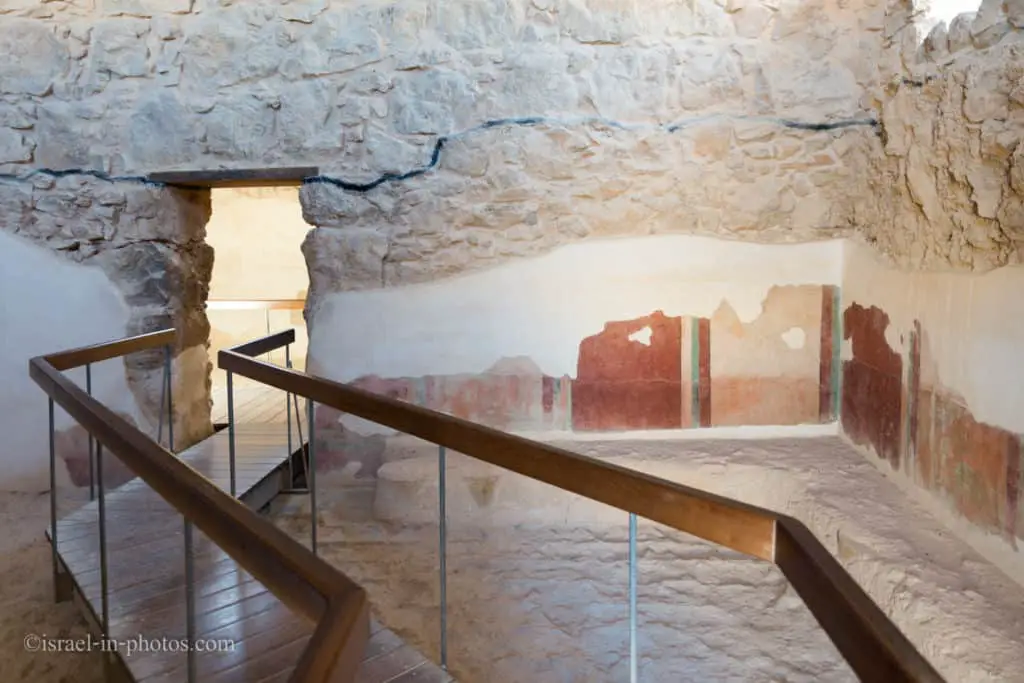
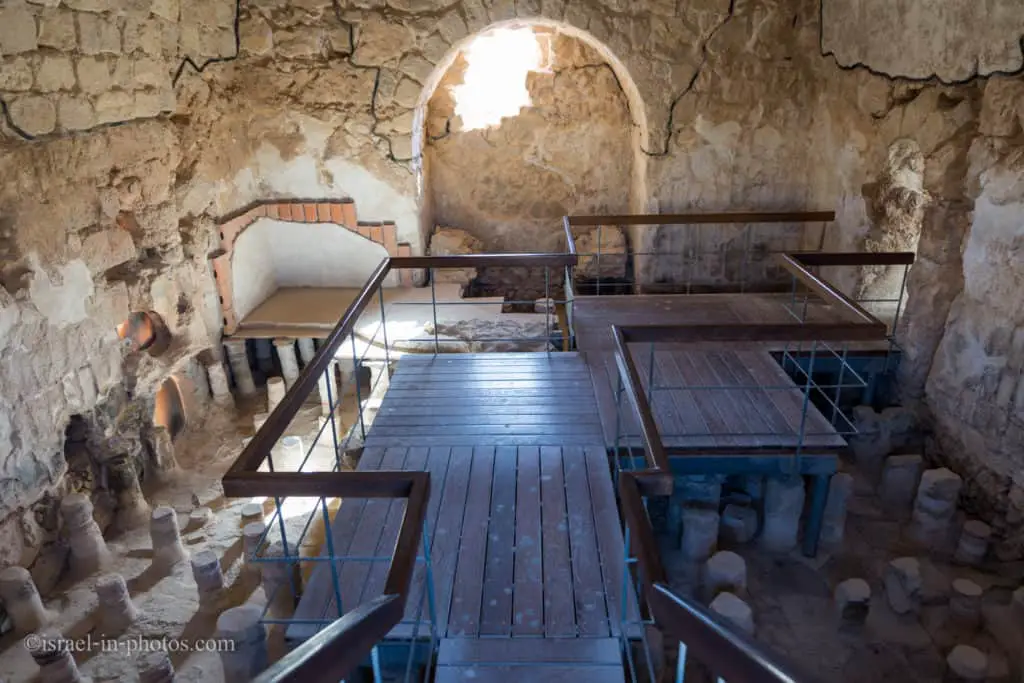
במהלך המרד, נבנתה כאן בריכת טבילה. בחדר פושר (tepidarium), ציורי הקיר השתמרו להפליא. פתח בקיר החדר הזה מוביל לבריכה המדרגת של החדר הקר (פרידיגריום), שבה הרצפה נשענת על עמודים קטנים. אוויר חם זרם דרך צינורות קרמיקה המשולבים בקירות, חימום החדר.
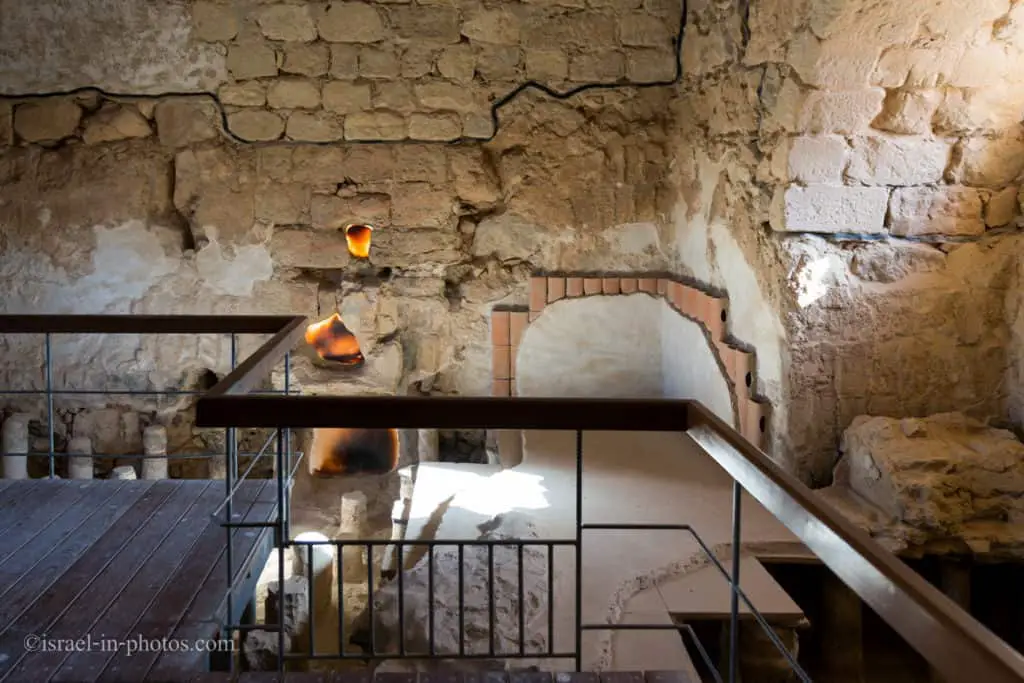
ה- “גורלות”
מיקום הגילוי של “גורלות” מסומן כנקודת העניין #8. במקום הזה, נמצאו כמה מאות שרידים רשומים. ויגאל ידין חיבר אותם עם יוספוס פלביוס’ סיפור המגרשים שצייר בלילה האחרון של המרד.

בחדר המגרשים - בחדר זה נמצאו שרידי חרס רבים (אוסטרקה), בעיקר עם שמות של אנשים, כולל 'בן יאיר', שמו של מנהיג הסיצרים, הקבוצה הדומיננטית בקרב מורדי מצדה. אלה היו אולי המגרשים שהטילו המורדים בלילה בו החליטו לשים קץ לחייהם, או שהם אולי היו קשורים לניהול החיים בקהילה המורדת.
אתה יכול לשאול מדוע הם משכו הרבה להרוג זה את זה. והסיבה שבגללה נבחרה דרך זו היא שהתאבדות נוגדת את האמונה היהודית.
חיות הבר
בעודם בחדר לוט, קיבלתי זריקה טובה של זרזיר של טריסטרם. לכן, בואו נדבר על חיות בר לרגע.
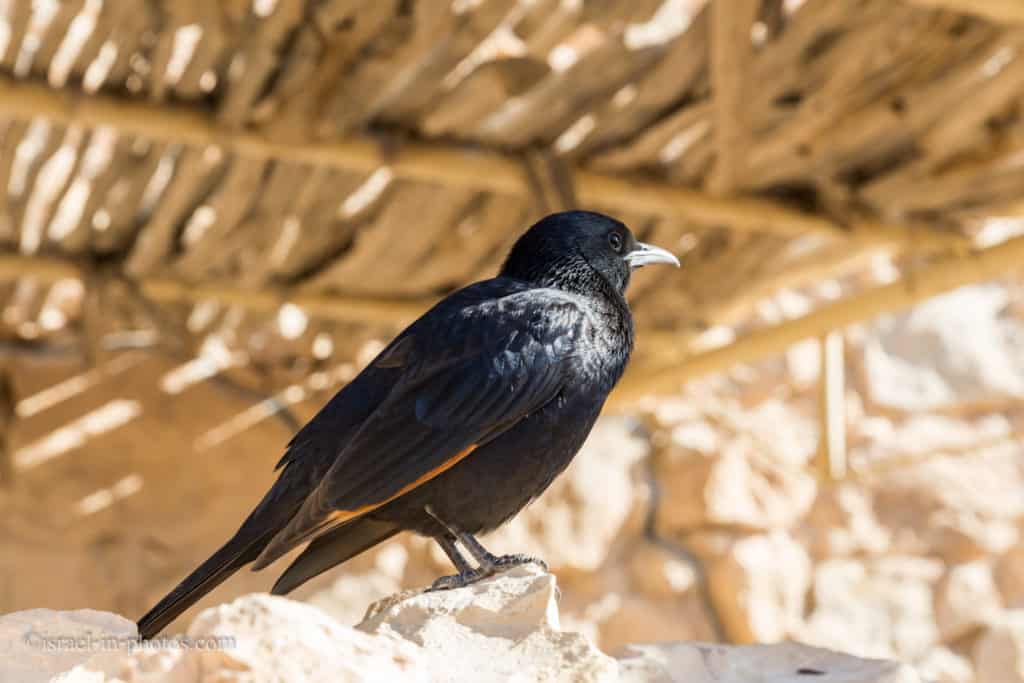
הסטארלינג של טריסטראם הוא ציפור קולית שקריאתה דומה לשריקה, שחור פחם עם פסים כתומים על כנפיו, שמורגשים בעיקר בטיסה. ההבדל העיקרי בין זכרים לנקבות הוא צבע ראשם - לנקבות נוצות אפורות, והזכרים, שָׁחוֹר. הזוהר של טריסטרם המתגורר סביב מצדה לא חושש להתקרב לבני אדם וניתן למצוא אותם בקרב המבקרים בזוגות ובקבוצות זכר-נקבה..
ציפור נפוצה נוספת היא זרזיר ים המלח, שזה בערך בגודל של דרור. ניתן לזהות אותו על ידי גופו האפור וזנבו השחור, שהוא מרבה לאוהד. ניתן לראות את העורב הזנב המאוורר מרחף בשמי מעל מצדה, ביצוע אקרובטיקה אווירית להנאתה, וכך גם העורב החום-צוואר.
למרגלות מצדה, יתכן שאתה פוגש יעלים, שגם התרגלו לנוכחותם של אנשים, ולהסתובב כאילו הם הבעלים של המקום.
המגדל
המגדל (נקודת עניין #25 על המפה) היא אחת הנקודות הגבוהות ביותר במצדה. משם, תוכל לסקור חלקים מהאתר. הנה כמה תמונות משם.
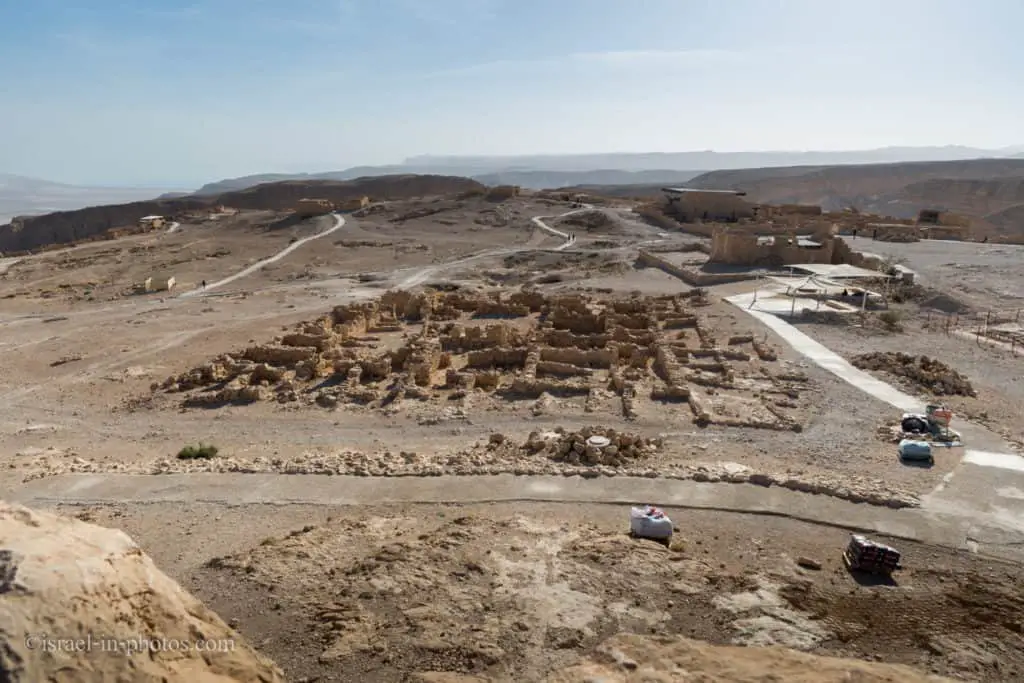
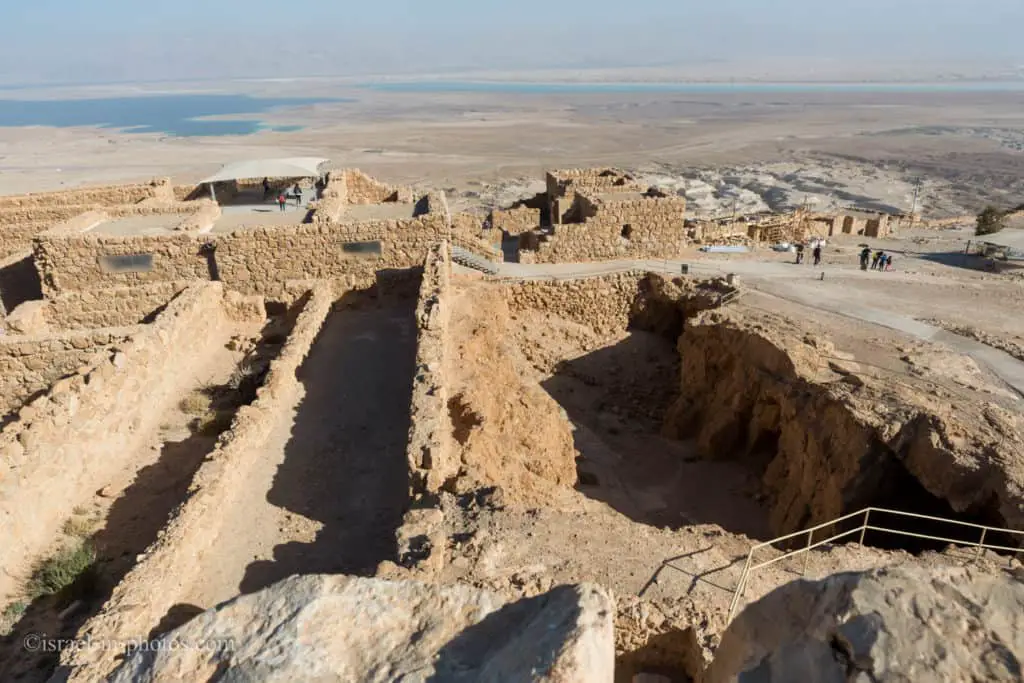
מים במצדה
אתה לא יכול לשרוד במדבר בלי מים, ומכיוון שאין זרימת מים קבועה, אתה חייב לאחסן אותו. לכן, נבנו כמה מתחמי בור.
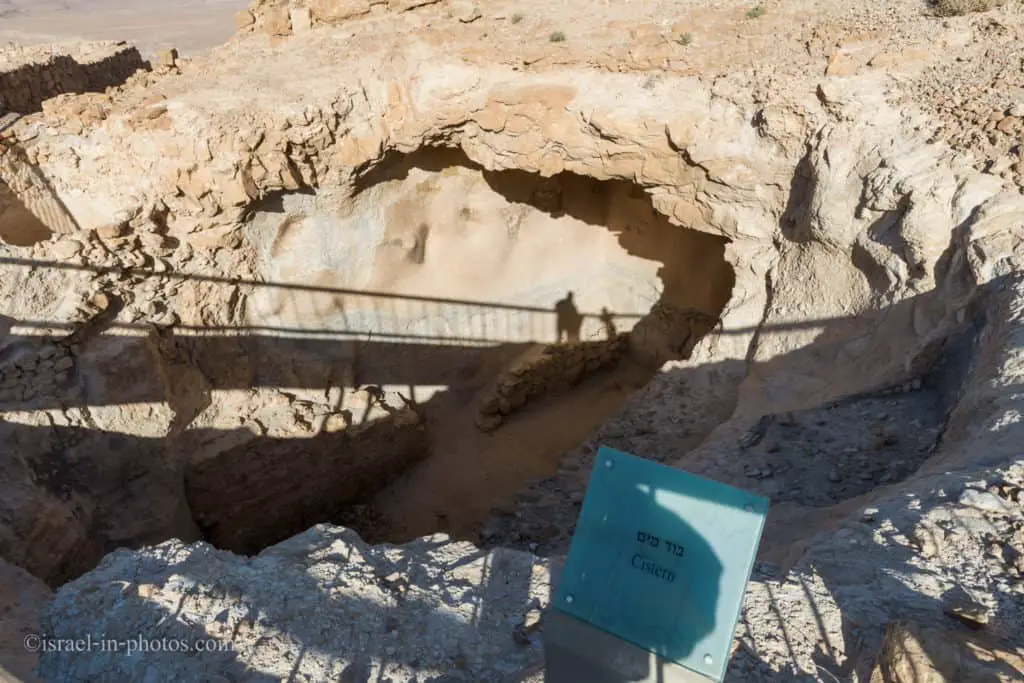
“בכל נקודה המשמשת למגורים, הן על הפסגה והן על הארמון, כמו גם לפני הקיר, הוא חתך בסלע טנקים גדולים רבים, כמאגרי מים, ובכך להשיג אספקה בשפע כמו במקום בו קפיצים זמינים.”
יוספוס פלביוס
מעבר לבורות מים, יש מערכת איסוף מים ייחודית. דגם באתר מדגים איך זה עובד.
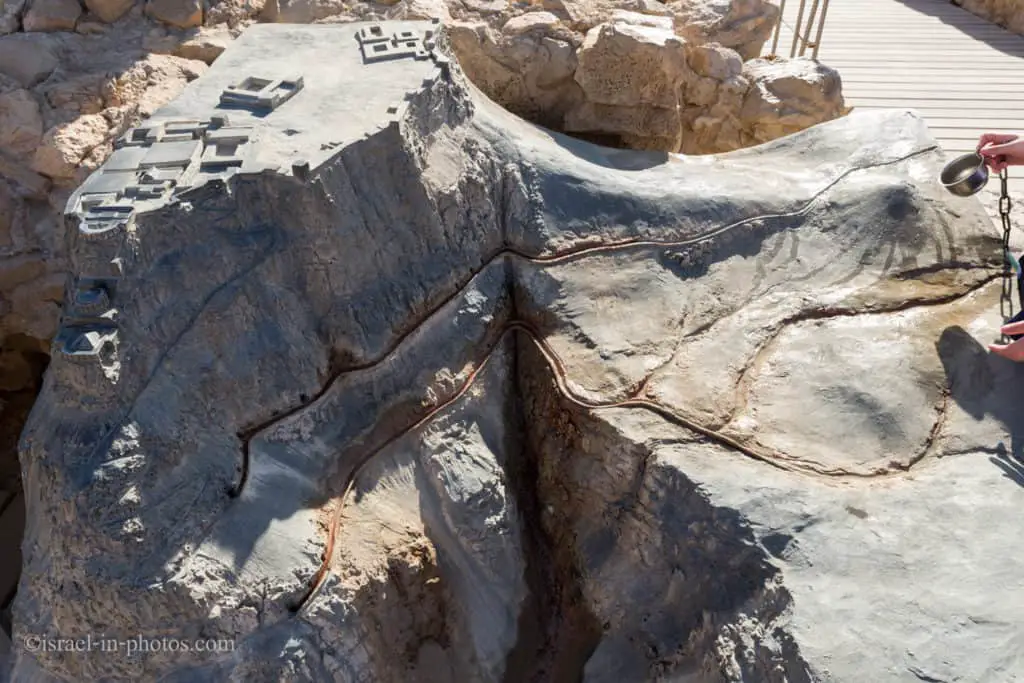
כפי שניתן לראות, כשזרמו מי גשם, סדרה של סכרי מים ואמות מים כיוונה אותה לבורות מים. לאחר מכן, שיירות של בעלי חיים הביאו את המים לראש הרמה דרך שער המים (נקודת עניין #9 בתכנית האתר) ובשביל הנחש. להלן ההסבר המלא לפי שלט באתר:
הפיתרון לבעיית המים במצודה המדברית הוא ללא ספק אחד מפלאי מצדה. לשרוד על ההר, הורדוס חצב בורות רבים בפסגה, והמדרון הצפון מערבי.
מי גשם שזרמו בשיטפונות בנחלים הסמוכים אוחסנו כאן. המים נאספו על ידי מערכת סכרים ושתי אמות מים, חלקים מהם ניתן לראות עד היום. במדרון נחפרו שתי שורות בורות מים, שמונה בשורה העליונה וארבע בתחתית, שהכיל 40,000 מטרים מעוקבים של מים. מבורות מים, שני שבילים הובילו אל ההר, האחת מהשורה העליונה לשער המים בצפון-מערב ההר והשנייה מהשורה התחתונה לשער דרך הנחש במזרח..
שיירות של בעלי חיים העלו את המים למסדה בשבילים אלה. כשהגיעו לפסגה, המים שפכו למערכת תעלות המובילה לבורות מים ברחבי ההר. אבל חובב חיים כמו הורדוס לא היה מסתפק רק במי שתייה. תכנון המים של מצדה כלל גם תשומת לב להיגיינה ובילוי, כפי שאנו רואים מבתי המרחץ ובריכת השחייה שנמצאת בחלקו הדרומי של ההר.
בית הכנסת
על המפה, נקודת עניין #12 הוא בית הכנסת.

בית הכנסת - מבנה ששימש בתקופת הורדוס כאורווה הפך לבית הכנסת על ידי המורדים. שני בורות שנחפרו ברצפת החדר ובה נמצא שברי מגילות תנ"כיות ששימשו כגניזה, ארכיב אחסון לטקסטים דתיים. ספסלים נבנו לאורך הקירות. זהו אחד מבתי הכנסת העתיקים הבודדים שהיו בשימוש בסוף ימי הבית השני. מדרום לבית הכנסת, בתוך ה “תיבת המגילות”, נמצא קובץ מאמרים מתקופת המרד, כולל קטעי מגילות ופפירוסים.
מגדל קולומבריום
קולומבריום (נקודת עניין #13 על המפה) הוא מתקן לגידול יונים. יונים שימשו למאכל ולשלשתן כדשן. קולומבריום נפוצה בשפלה יהודה. היום, אתה יכול לראות אותם ב חורבת מדרס ו- גן לאומי בית גוברין (תוכל למצוא מידע נוסף על קולומבריום באותו פוסט).
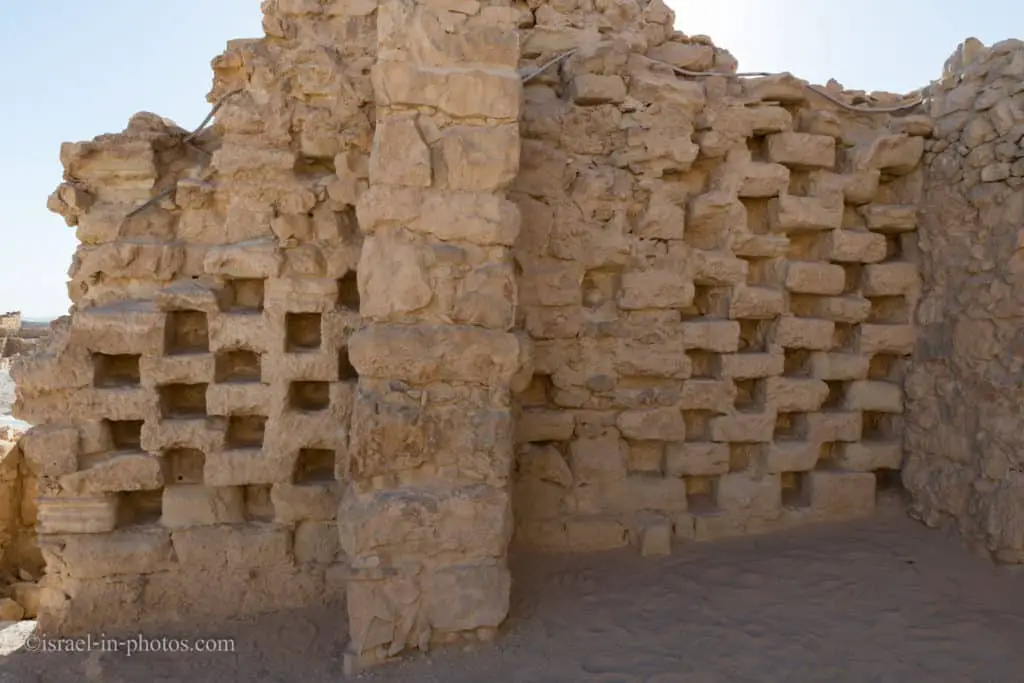
המצור על מצדה
ליד הקולומבריום, תמצא את נקודת הפריצה (נקודת עניין #14 על התוכנית באתר). כאן, הסתיים המצור על מצדה. לכן, בואו נרחיב את הנושא הזה.
מעוז המורדים האחרון
על פי יוסף בן מתתיהו, מצדה הייתה מעוז המורדים האחרון ביהודה. ב- 73 או 74 לספירה, הלגיון העשירי הרומאי פרטנסיס, בראשות פלביוס סילבה, הטיל מצור להר. הלגיון, המורכב 8,000 כוחות שביניהם היו כוחות עזר, בנו שמונה מחנות סביב הבסיס, קיר מצור, ורמפה עשויה אדמה ותומכי עץ במדרון טבעי מערבה. יהודים בשבויים הביאו מים לחיילים, כנראה מעין גדי, כמו גם אוכל.
הערה: אתה יכול למצוא את התיאור המלא בקטע ההיסטוריה.
הרמפה
הרמפה - מערבית למסדה הוא רכס שהוא פשוט 60 מ 'נמוך מקצה ההר. בשנה 73 לספירה, כאשר הרומאים מצרו על הקנאים שעשו את מעוזם על ההר, הם ניצלו נפילת סלע טבעית באתר זה ובנו מעליו רמפה ארצית, נתמך על ידי קורות עץ.
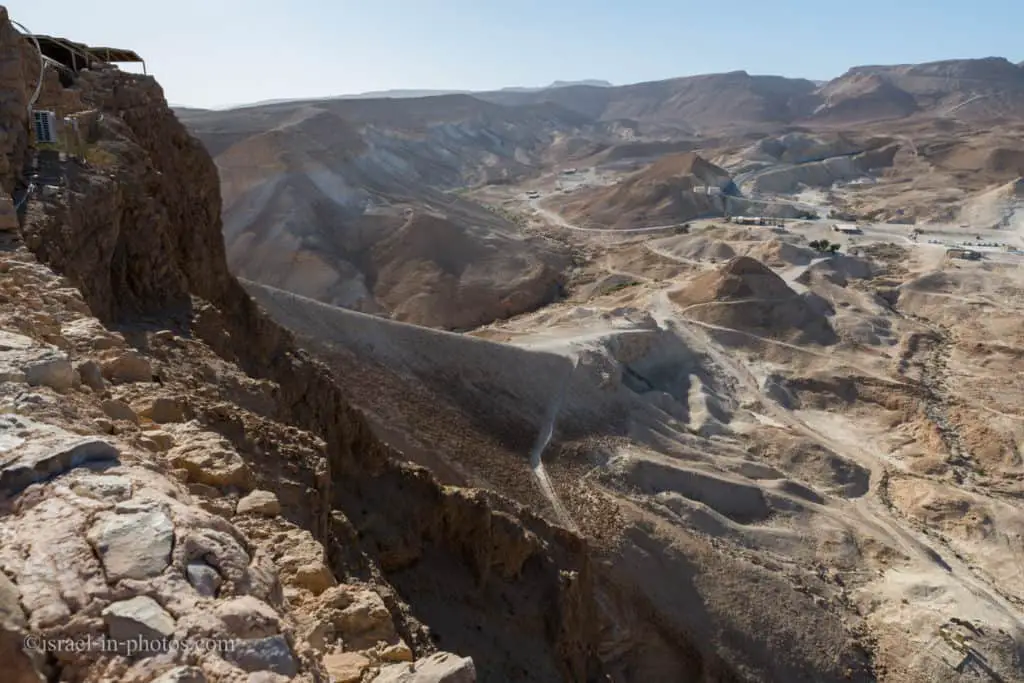
מגדל המצור
אחרי כמה חודשים, הרומאים סיימו לבנות את הרמפה.
בראש הרמפה עלה מגדל המצור, ובתוכו היה האייל החבוט שאיתו תקפו הרומאים את חומת הקאסמט. עם זאת, המורדים בנו חומה של אדמה ועץ, כנגדו היה האיל המוכה לא יעיל:
“התבוננות בזה, סילבה, מתוך מחשבה שקל יותר להרוס את החומה הזו באש, הורה לחייליו לזרוק אליו ממטרים של לפידים בוערים ... עם פרוץ השריפה הראשון, רוח צפונית שנשבה בפניהם של הרומאים גרמה להם להבהל מפני שהסטת הלהבה מלמעלה, זה הסיע אותם נגדם ... ואז פתאום, הרוח מסתובבת, כאילו מתוך השגחה אלוהית, לדרום ונשף במלוא העוצמה בכיוון ההפוך, ניפנף והעיף את הלהבות על הקיר, שעכשיו דרך ומעבר היה כל בוער.”
יוספוס פלביוס

הלילה האחרון
כשירד הלילה, והיה ברור שהמצב חסר תקווה וכי הרומאים יתפרצו עם שחר, אלעזר בן יאיר כינס את חסידיו וקרא להתאבד המוני:
“הרומנים, ציפייה להתנגדות נוספת ... הפסידה להעלות על הדעת מה קרה… כאן נתקלים במסת ההרוגים, במקום לשמוח כמו על אויבים, הם העריצו את האצולה של נחישותם ואת זלזול המוות שהפגינו כל כך הרבה בביצועו, לא מתרחש, להוצאה להורג.”
יוספוס פלביוס
מי שרד את המצור על מצדה?
על פי יוסף בן מתתיהו, שתי נשים וחמישה ילדים שהסתתרו בבורות מים על פסגת ההר, סיפרו לרומאים מה קרה באותו לילה, ב -15 בניסן, היום הראשון של חג הפסח.
כמו כן, על פי דברי יוספוס ומבוסס על עדותם של הניצולים, אלעזר בן יאיר אמר למורדים הנותרים להשמיד את כל מה שבמצדה פרט לאספקת המזון. בכך, הוא רצה להראות לרומאים שהם בחרו במוות בגלל העבדות.
הארמון המערבי
ועכשיו, ניכנס לבניין המשמעותי ביותר במצדה, הארמון המערבי (נקודת עניין #17 על המפה).

הארמון המערבי - ארמון זה הוא הבניין הגדול ביותר במצדה, 3700 מ"ר בגודל, נבנה על ידי הורדוס. בלובי הכניסה יש ספסלים מובנים, והקירות מעוטרים בעיצובים של טיח. על הסיפור הראשון אולם. בגלל ארבע שקעים ברצפה בה היו יכולים להיות מונחים רגלי כס המלך, ההנחה היא שזה היה ה- “חדר הכס”. מעוף מדרגות מוביל לסיפור השני, המשקיף אל מתחם הרחצה למטה, עם רצפת הפסיפס המרהיבה.
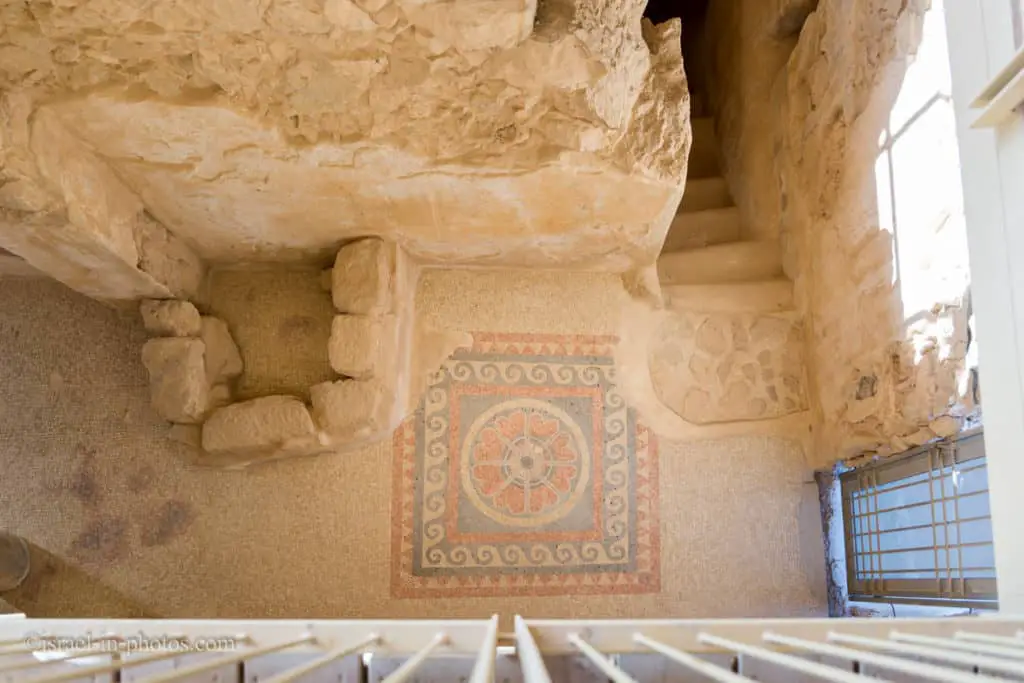
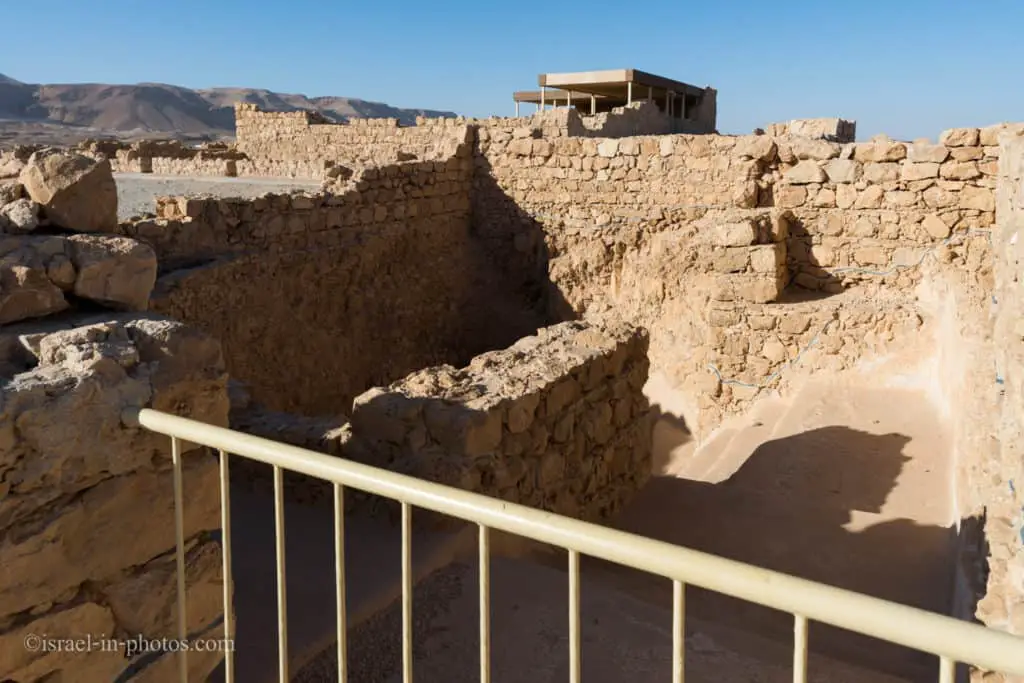
ישנן נקודות עניין נוספות במצדה, אבל כמו שציינתי, נבקר רק בעיקרים.
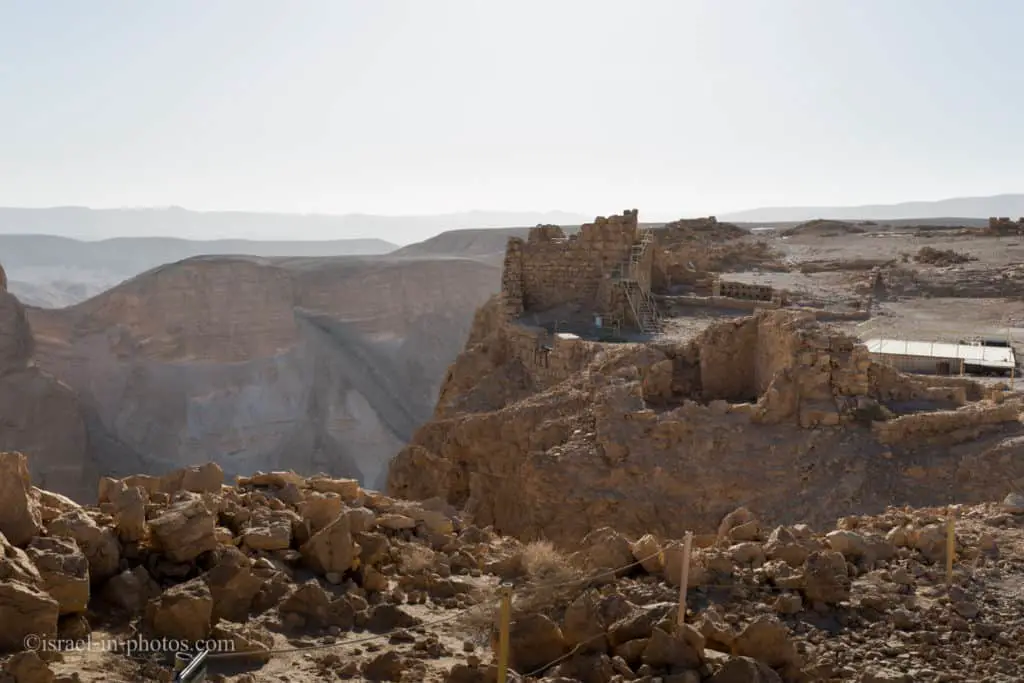
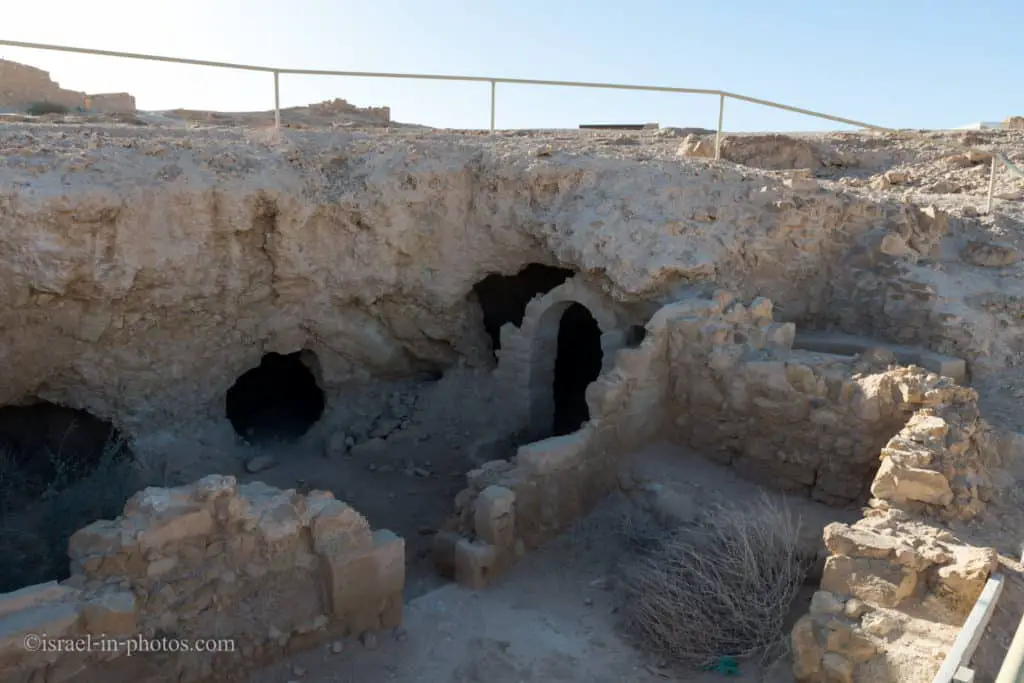
כמה זמן לוקח ביקור במצדה?
ביקור טיפוסי במצדה אורך שעתיים שלוש. מהזמן הזה, כשעה מושקעת בטיפוס בשביל הנחש. לכן, הייתי אומר ששעתיים זה כנראה הזמן המינימלי המוצע.
הביקור האחרון שלנו ארך כמעט ארבע שעות. השתמשנו ברכבל כדי לעלות ולרדת (כך שלא בילינו זמן בשביל הנחש). ולמרות זאת, לא כיסינו את הכל. לכן, אתה יכול בקלות לבלות חמש או יותר שעות במצדה.
חשיבותה של מצדה
ראשית כל, מצדה היא אתר היסטורי. ב- 1968, מצדה הוכרזה כפארק לאומי בשטח של 3,400 דונם, וב- 2001, אונסק"ו הכריזה כאתר מורשת עולמית.
“מצדה לא תיפול שנית”
אבל מעבר לזה, מצדה הפכה לסמל. לפני כמאה שנה, התנועה הציונית אימצה את סיפור מצדה. הוא ייצג את המיתוס של שאפתנות לחופש, התחדשות לאומית, וריבונות.
בשנות השלושים, מצדה הפכה לאתר עלייה לרגל עבור מטיילים ותנועות נוער. לאחר הקמת ישראל, הרמטכ"ל של צה"ל, משה דיין, יזם מגייסי חיל שריון של צה"ל שנשבעו בשבועה הצבאית בצמרת מצדה (לאחר סיום הכשרה בסיסית).
הטקס הסתיים בהכרזה: “מצדה לא תיפול שוב.” החיילים טיפסו על שביל הנחש בלילה והושבעו עם לפידים שהאירו את הרקע. טקסים אלה נערכים כעת גם במקומות אחרים, כולל אנדרטת חיל השריון בלטרון, הכותל המערבי וגבעת התחמושת בירושלים, כלא עכו, ובסיסי אימונים.
מקור: ויקיפדיה
שאלות נפוצות
מצדה הייתה מעוז המורדים היהודים האחרון ביהודה במהלך המלחמה היהודית-רומית. וכשהמורדים היהודים שהתקשרו לסיקארי הבינו שהם עומדים להפסיד, הם העדיפו למות כגברים חופשיים במקום לחיות כעבדים. לכן, הם ביצעו התאבדות המונית.
מצדה ידועה כי המצור הוא מצדה. בזמן הזה, המורדים העדיפו למות כגברים חופשיים במקום לחיות כעבדים. לכן, הם ביצעו התאבדות המונית.
לפני כמאה שנה, את סיפור מצדה אימצה התנועה הציונית. הוא ייצג את המיתוס של שאפתנות לחופש, התחדשות לאומית, וריבונות. עיין בסעיף החשיבות של מצדה במדריך זה.
על פי יוסף בן מתתיהו, 960 הקנאים היהודים מתו במצדה.
אם אתה לוקח את הכניסה המערבית, השלמת רמפת המצור נמשכת חמש עשרה דקות. ואם אתה לוקח את הכניסה המזרחית, סביר להניח שתמשיך בדרך הנחש, שנמשכת כשעה.
הטיפוס מהכניסה המערבית קל יחסית. ושביל הנחש בכניסה המזרחית מאומץ יותר. אבל אם אתה במצב טוב, זה לא אמור להיות בעיה. יתר על כן, זכור שתטייל במדבר. לכן, מזג האוויר משחק תפקיד משמעותי. לפרטים נוספים עיין בסעיפים הרלוונטיים לעיל.
מצדה פירושה מבצר או מעוז.
מצדה בהחלט שווה ביקור. זהו אחד הפארקים הלאומיים הפופולריים ביותר בישראל, והוא מציע נופים מדהימים, שרידים ארכיאולוגיים, וסיפור נהדר.
כן. נסעתי לשם הרבה פעמים ואף פעם לא היו לי בעיות.
ביקור טיפוסי במצדה אורך שעתיים שלוש. אם אתה לוקח את שביל הנחש, הטיפוס ייקח שעה אחת. לכן, הייתי אומר ששעתיים זה כנראה הזמן המינימלי המוצע. ביקור מעמיק יותר ייקח ארבע עד חמש שעות.
סיכום
הפארק הלאומי מצדה הוא אחד האתרים המשמעותיים בישראל. כללתי אותו ברשימת הטובים ביותר שלי גנים לאומיים ושמורות טבע. ואם אתם מבקרים ירושלים או ים המלח, לשקול לעשות עיקוף למצדה.
האם ביקרת אי פעם בפארק הלאומי מצדה? ספר לנו על החוויה שלך בתגובות למטה.
זה הכל להיום, ואני אראה אותכם בטיולים נוספים!
המשיכו לעקוב!
משאבים נוספים
הנה כמה מאמרים שיצרתי כדי לעזור למטיילים:- תכנון טיולים עם אטרקציות ומסלולים הוא העמוד שיעזור לכם ליצור את המסלול המושלם עבורכם.
- מהו הזמן הטוב ביותר לבקר בישראל? כדי לענות על השאלה הזו, נקח בחשבון את מזג האוויר, מחירים, חגים, פסטיבלים, ועוד.
- מידע וטיפים לתיירים לישראל יענה על השאלות הנפוצות ביותר שיש לתיירים על ישראל (כולל בטיחות, דרכונים, מזג אוויר, מטבע, טיפים, חשמל, ועוד הרבה).
- גנים לאומיים ושמורות טבע לכלול רשימה מלאה, את עשרת הטובים ביותר, מפה, כרטיסים (Israel Pass, מטמון, כרטיס משולב, ואתרי קמפינג.
- אם אתם מחפשים דברים לעשות, הנה העמודים של ירושלים, תל אביב, חיפה, הכנרת, עכו, אילת, נצרת, צפת, ו- מכתש רמון.

